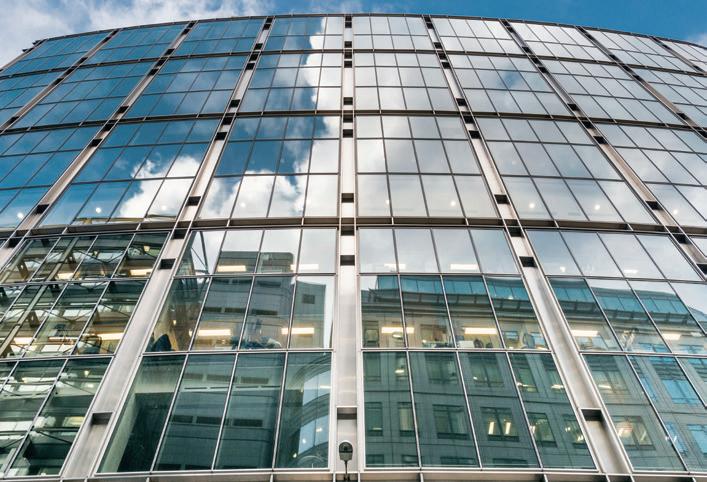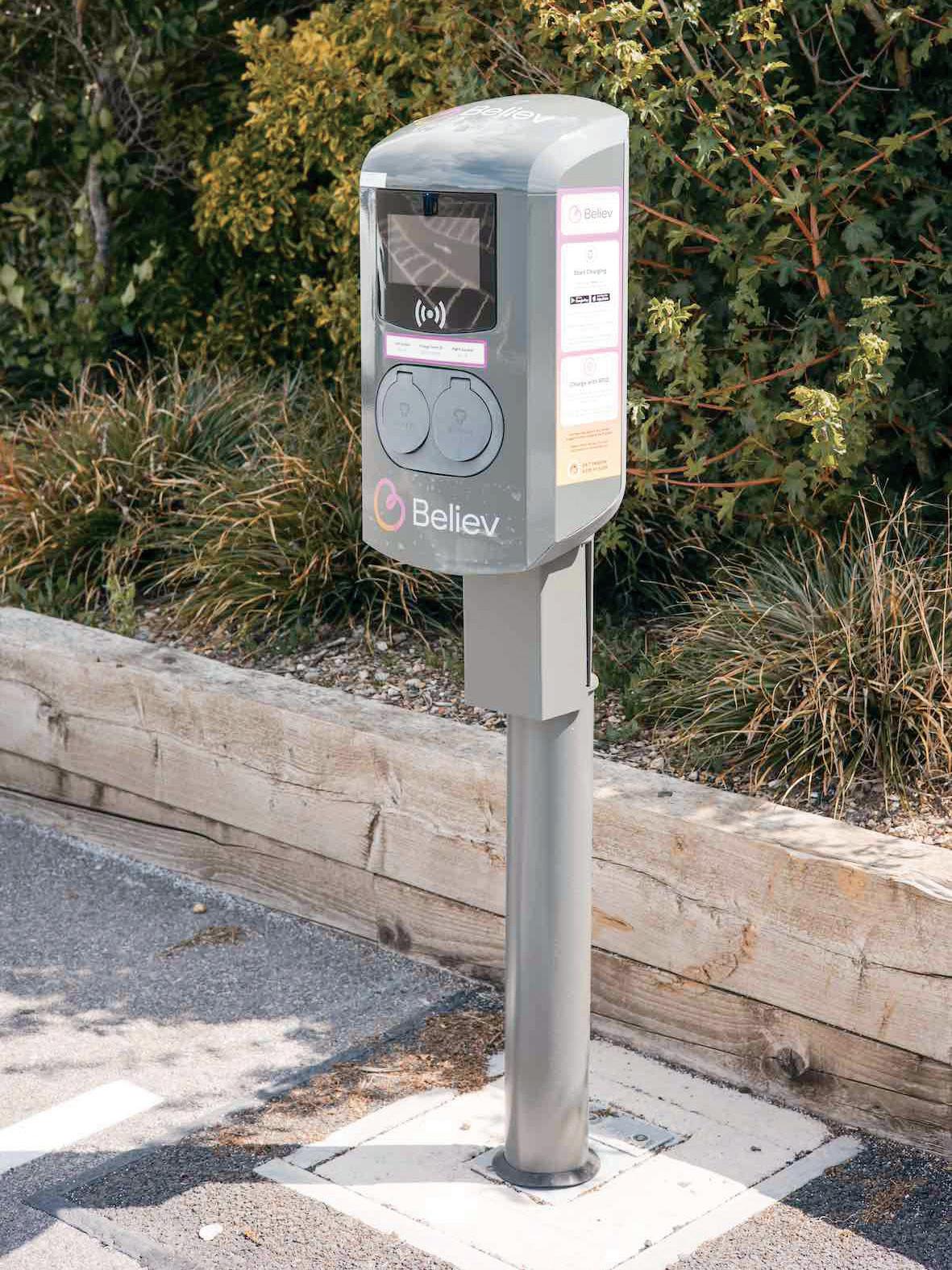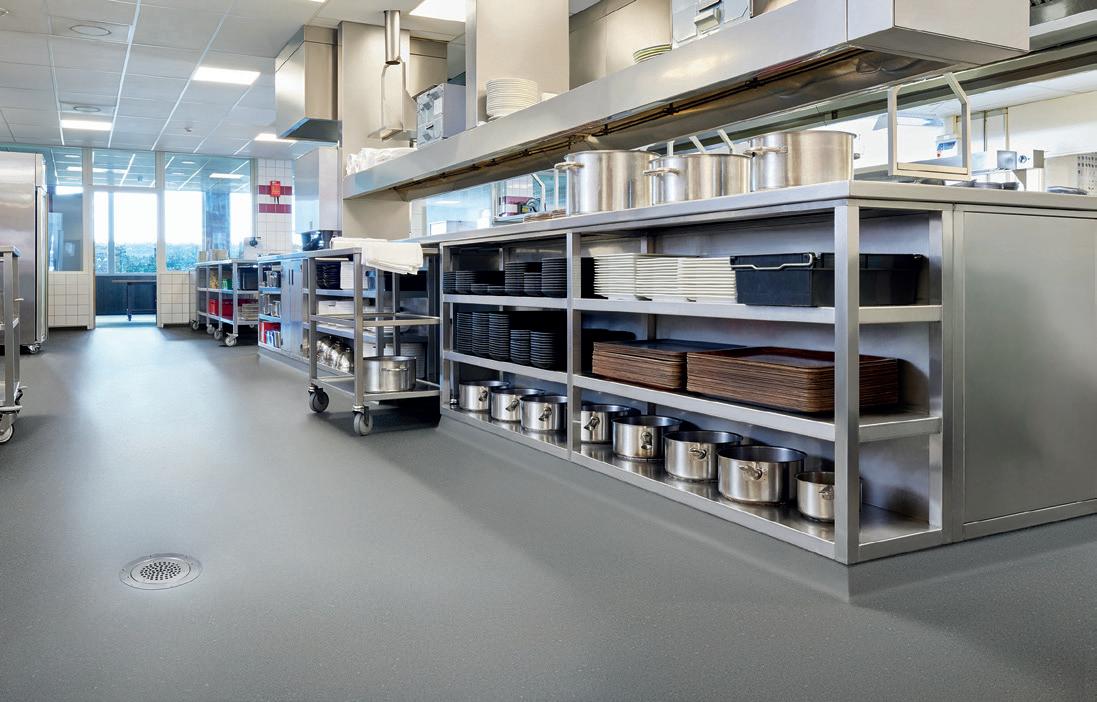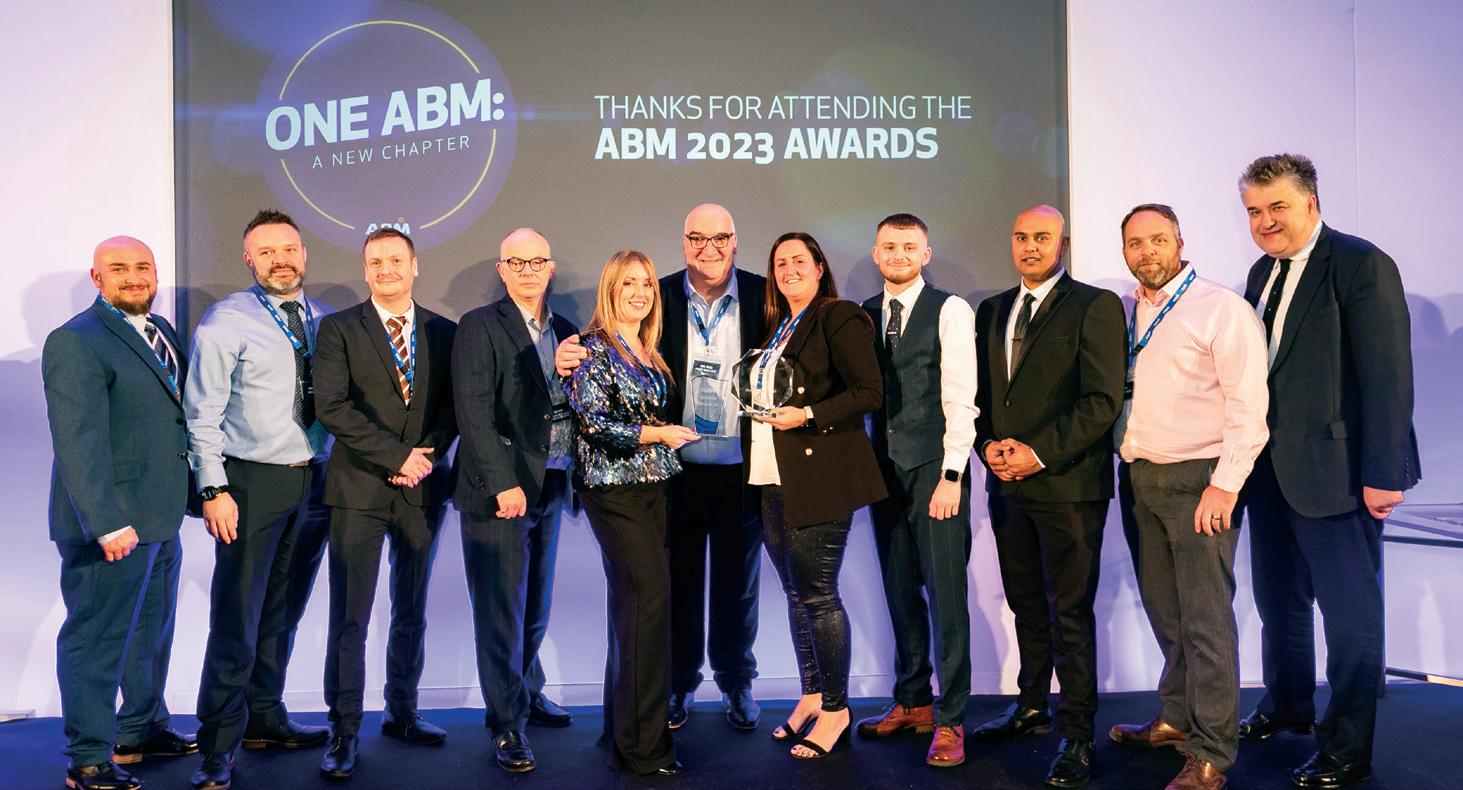






FACILITIES MANAGEMENT JOURNAL VOLUME 32 | 06 JUNE 2024 WASHROOMS The latest innovations SUSTAINABLE TRAVEL Fleet solutions 40 32 CATERING Reducing food waste 28 FM Clinic: Can smaller estates with more attractive spaces meet the hybrid challenge? WINNING WAYS British Land’s Broadgate FM team wins the CIBSE Building Performance award for carbon saving initiatives Navigating excellence. Facilities & Estates Management Live O cial magazine



























































24/7 Nationwide UPS & Generator Experts The People You Can Trust: Steve Lead Generator Engineer Northern Engineer Team 0345 200 9888 yorpower-group.com group.com The Experience You Can Trust: 2,585 Generators Under Contract in the UK 1,856 UPS Under Contract in the UK 1,516 Generators Sold Last Year 315 UPS Sold last Year

kpm media Unit 1 Mill Place, Platt Business Estate, Maidstone Road, Sevenoaks, Kent TN15 8TB Tel: 01322 662289
Editor Sara Bean sara.bean@kpmmedia.co.uk
Assistant Editor & Social Media Development
Sarah O’Beirne sarah.obeirne@kpmmedia.co.uk Tel: 01322 476815
Director & Designer Warren Knight warren.knight@kpmmedia.co.uk Mob: 0780 1947757
Sales Director Danny Grange danny.grange@kpmmedia.co.uk Mob: 07867 418994
Business Administrator & Circulation Maxine Howell maxine@kpmmedia.co.uk
Accounts Diane Jarvis accounts@kpmmedia.co.uk
Group CEO Nigel Copp nigel.copp@kpmgroup.co.uk
Editorial steering committee
Alan Hutchinson, Facilities Director, Howard Kennedy LLP
Charles Siddons, Head of Operations, NHS Property Services
Darren Miller, Group Head of Real Estate & Workplace, Experian
Ian Wade, Head of UK Estates, British Medical Association
Lucy Hind, Senior FM Lecturer, Leeds Beckett University
Paul Cannock, Head of the Estates and Facilities Management Department, European Space Agency
Russell Wood, Senior Facilities Manager at Travers Smith LLP
Russell Burnaby, Head of FM, Regeneration and Environment, Brent Council
Simon Francis, Director of Estates and Facilities, The Institute of Cancer Research
Simone Fenton-Jarvis, Group Director of Workplace Consultancy and Transformation, Vpod Solutions
Wayne Young, Facilities Manager at DB Cargo (UK)
Total Average Net Circulation 12,150 July 2022 to June 2023 SUPPORTED BY

kpm media adopts a sustainable policy of using paper from managed forests. Printed in the UK by The Gemini Print Group www.gemini-print.co.uk
© Copyright 2024 kpm media
The publisher does not necessarily agree with the views and opinions expressed by contributors. No material may be reproduced in part or whole without written permission from the editor. Editorial contributions are accepted on an all-rights basis only. Letters to the editor may be published in their entirety or in edited form and remain the property of kpm media. While due care is taken to ensure the accuracy of information contained in this magazine, the publishers cannot be held responsible for any errors in editorial articles or advertisements. Subscriptions are available to non-qualifying and overseas readers at £120 p.a. (UK), £160 p.a. (EU countries) and £240 p.a. (overseas-other).

The findings of the Institute of Workplace and Facilities Management’s (IWFM) annual market report (see news page 07) has revealed some interesting trends. It seems that despite concerns about the negative impact of hybrid working on the sector, organisations have actually increased the area of space being managed in the last 12 months.
These indicators are a very positive sign and tie in nicely with the topic of discussion in this month’s FM Clinic (pg 20), which asked whether smaller estates with more attractive spaces were the best approach in meeting the hybrid challenge?
As Dan Andrews of CBRE explained, the answer is multifaceted. Occupiers are not only looking for spaces which o er opportunities for better collaboration and workplace technologies, but they want their spaces to o er first rate sustainability accreditations. This echoes the further findings in the IWFM report which found that the fastest growing area of investment in the sector over the past 12 months has been in carbon reduction solutions.
With earlier IWFM research suggesting that one in three FMs were ordinary stakeholders at best when organisations were drawing up energy e iciency and carbon reduction plans, it’s more important than ever they demonstrate the benefits of their expertise. It’s inspiring then to hear that British Land’s Broadgate FM team won the Facilities Management category at this year’s CIBSE Building Performance Awards for, in the words of the judges, “taking an active role in the decarbonisation of buildings and energy management”.
The FM team used a series of net zero audits to benchmark the buildings’ carbon footprints, identify e iciencies and potential actions needed to achieve carbon reduction goals. It’s a brilliant example of how British Land’s Broadgate FM team’s ability to share energy data with the buildings’ occupiers helped benefit building occupiers and other stakeholders. Read the profile of the winning entry on page 24.
As always, we’d welcome your feedback about any aspect of the magazine, together with your insight into what’s happening in the FM sector.
JUNE 2024 3 FMJ.CO.UK comment this month... FACILITIES MANAGEMENT JOURNAL JOBS Find your next role with the FMJ Jobboard Visit jobs.fmj.co.uk for hundreds of roles in FM and associated industries jobs. fmj.co.uk
sara.bean@kpmmedia.co.uk
EDITORIAL COMMENT











ADDING MORE STRINGS TO OUR BOW...
We’ve added innovative new services to our already comprehensive range of fuel solutions, making us your one-stop-shop for all your business’ environmental needs.
Our updated services list includes:
Single skin Belzona tank lining
Double skin Rafibra tank lining
Foam filling services
BioBug remote tank cleaning
Fuel uplift & transfer
HVO fuel switching services
Fuel testing & polishing
Tank & pipework services
NDT integrity testing
Industrial tank cleaning
Tank decomissioning & more!
Find out more about our services here:






W: CROWNOILENVIRONMENTAL.CO.UK T: 0330 123 3399 E: SALES@CROWNOILENVIRONMENTAL.CO.UK
New!






THIS MONTH...
This month’s summary of everything that has hit the headlines in the FM sector.
The latest news and views from membership organisations.







Steve Harding from Business Moves Group shares best practice advice on why, when and how to utilise storage.
Solar panels could be the cure for the energy crisis hangover, says James Cunningham, MD, Geo Green Power.
14
CIOB Client Champion Paul Nash explains the responsibilities of the client as a duty holder under the Building Safety Act and related secondary legislation.
David Aird, Director of Strategic Projects at Amey discusses digital innovation within a challenging public landscape.
18 Konnor Baskaran, FM lead at Mpro5 advocates a greater role for FMs in fostering accessible and inclusive environments.
20 We asked a group of experts. Are smaller estates with more attractive spaces the key to solving the hybrid challenge and what is the FM role in supporting remote workers?




Daniel Lessiter, Head of Business Partnerships at charge point operator
Believ, explains how an EV charging infrastructure plays a key role in supporting sustainable transport.
SECURITY
36

Anastasia Mylona, Technical Director at CIBSE explains the reasons why British Land’s Broadgate FM team won the Facilities Management category at this year’s CIBSE Building Performance Awards.
CATERING
Facilities managers are working together with their foodservice partners to help solve the food waste problem and lower their carbon footprint, reports Sara Bean.
SUSTAINABLE TRANSPORT
James Maden, Director at Nexus explains the sustainable di erences between owning and renting a vehicle fleet.


There has been a rise in popularity of electronic key management systems, in place of the traditional manual key and lock systems We explain why.
38 David Aindow from Synectics explains how the tools within integrated security and surveillance solutions can help protect large-scale retail venues.
WASHROOMS
40 Craig Bowman of KCP describes how innovations in the washroom are creating smarter, greener, more hygienic and accessible environments for users.
42
For organisations aiming to decrease their environmental impact, one area which is o en overlooked as part of a wider sustainability strategy is the washroom, says Alasdair Sharp.
HEALTH AND SAFETY
43






management profession.

Simon Barnes, VP Sales, ABM UK & Ireland says, when it comes to FM, it’s important to support the one team approach.
Martin Hottass, Corporate Development Director at 3t suggests ways of bridging the construction skills gap.
roundup of the latest careers news in the facilities management sector.
Safety flooring can be a vital part of any interior design scheme. However, who said that this means you have to be conservative with design? asks Craig Thornhill.
New product and service launches and company news from the FM industry.
We present valuable insights from our editorial steering committee of client-side FMs on a variety of topics, from AI to ESG. In the FM Clinic, whether it is o setting or misleading ‘ecofriendly’ claims, greenwashing comes in many forms; what can FMs do to avoid it undermining their sustainability goals? With the increasing trend to automate the visitor experience, we discover ways front of house providers are continuing to deliver a personal touch. How the latest tech can ensure HVAC services are delivered by appropriately qualified engineers, with the right skills, asset history and correct parts and a BMS can be linked to renewable energy sources such as solar panels and heat pumps. And a focus on the cleaning priorities for di erent kinds of non-residential environments, including retail and o ice.
JUNE 2024 5 FMJ.CO.UK
34
PEOPLE 51 Find
facilities
RECRUITMENT 52
out who’s moving where in the
TRAINING 53
CAREERS NEWS 54 A
CASE STUDY 24
brief
28
32
FEATURES 24 FM CAREERS 53 sara.bean@kpmmedia.co.uk Next Edition
To register for your free copy of FMJ visit fmj.co.uk MIFM 44
OPINION 10
COMMENT
12
COMPLIANCE
FAST FACTS 16
BLOG & SOCIAL MEDIA
FM CLINIC
ADVICE AND OPINION NEWS & ANALYSIS 12 FMJ NEWS
06
ASSOCIATION NEWS
08
CONTENTS Follow us on Facebook and Twitter @FMJtoday
LEGAL VIEW


WORKPLACES NEED TO DO MORE TO PREVENT FATAL ACCIDENTS
Kirstie Jones, Head of Client Services and Environmental Health Expert at Navitas Safety
The tragic death of a council refuse worker in Coventry earlier this year has brought the importance of workplace safety back into the spotlight. The incident, deemed ‘foreseeable’ by the jury foreman, highlighted significant failings in safety protocols. Jurors also pointed out that a culture of under-reporting incidents and near misses contributed to an increased risk of missed opportunities to keep the victim safe.
This workplace fatality, which made the mainstream news, is not an isolated case. Official statistics reveal 135 workers were killed in work-related accidents in Great Britain in 2022/2023.
These figures are released each year, and although on the decline, the same question arises: could these deaths have been prevented?
The reality is, in many of these cases, a comprehensive incident reporting process - which includes near misses - could’ve identified potential hazards and weak spots before they escalated into larger incidents with devastating consequences.
Here, we share advice on how and why businesses need robust accident and reporting procedures in place.
Incident reporting and the legal requirement In UK law, a company is legally responsible for the reporting of certain incidents, near misses and accidents to the Health and Safety Executive (HSE). This falls under RIDDOR, which stands for Reporting of Injuries, Diseases and Dangerous Occurrences Regulations. RIDDOR requires responsible persons to outline ‘reportable incidents’ that have occurred in the workplace, which includes non-fatal accidents to people other than workers.
What is a near miss accident?
A near miss is a type of accident that could have caused injury, harm or damage to a person or property. Due to their less serious nature, they tend to be brushed aside, but these incidents act as early warning signs highlighting safety concerns.
What are the best practices for incident reporting?
Although procedures may differ from business to business, they are more effective when the following applies: The process is simple yet comprehensive. Pen and paper will suffice, and there are no legal obligations to keep a digital trail of evidence. Every incident, no matter how seemingly insignificant, holds valuable information for improving safety.
Employees are clear of the process - and why it’s in place
Being vigilant is everyone’s responsibility, which is why all employees should be aware of the different types of accidents (including near misses) and what to do should they see anything. Regular training and refreshers will help with this, along with the introduction of a company-wide motto such as ‘see it, sort it, report it’.
Every single incident is logged
Employees should understand that no incident is too small to report, and that safety always comes first. Fostering a positive safety culture where employees are praised for bringing hazards to light is crucial.
The data is regularly analysed
Having incident reporting data at your fingertips means you can look at the bigger picture. And by doing this, you are far more likely to be able to put appropriate measures in place to stop an issue from happening again.
In conclusion
By taking the above steps, organisations are showing their employees that they care about fostering a culture not just of safety, but of continuous improvement.
CLEANING & FM INDUSTRY HONOURED AT 2024 GOLDEN SERVICE AWARDS
Eighteen coveted awards were presented at the cleaning industry’s most celebrated event – 2024 Kimberly-Clark Professional Golden Service Awards –on 23 May, at the London Hilton, Park Lane.


Created over 30 years ago, the biennial Golden Service Awards is today one of the most must-have and sought-a er accolades in the FM and cleaning industry – proven by a 30 per cent increase in the number of entries this year.


The Golden Service Awards once again has provided the opportunity for FM companies, contract cleaners and in-house cleaning teams to showcase their outstanding excellence and commitment to deliver performances that continually raise standards and set new performance benchmarks.
The awards were presented to the worthy recipients by Craig Bowman, General Manager UK & Ireland, Kimberly-Clark Professional and comedian, actor and writer Hugh Dennis.
Speaking about the awards, Bowman said: “Congratulations to all our outstanding and worthy winners and also to our well-deserved finalists in 2024.
“Once again, we have a year of unrivalled and outstanding standards from our industry peers here at the Golden Service Awards. We see more evidence of exceptional achievements despite the challenges of sta shortages, financial uncertainty and the continued post pandemic spotlight on hygiene and cleanliness. The high standards reached in our industry reflect our focus as a business and our values which we have evolved over the 150 years of Kimberly-Clark. We strive to keep people healthy, safe and sustainable through our work with customers and partners, because this industry makes a real di erence to lives.”
Kimberly-Clark Professional again partnered with the British Institute of Cleaning Science (BICSc) who oversaw the independent judging.
To see the award winners visit https://www.goldenserviceawards.co.uk/en-gb/ award-results/2024-winners
FM IS A TOP PERFORMER WHEN IT COMES TO SOCIAL VALUE DELIVERY
The FM industry delivers an average £3.5 million in Social Value per project, according to a new data driven insights report, launched by online measurement and reporting solution Social Value Portal (SVP).
It has found that while Social Value has recently gained unprecedented momentum throughout the UK, there are some clear front runners delivering meaningful change to local communities.
The industry-first report draws on data held by SVP dating back to 2016 and analyses Social Value commitments and delivery across the public, private and third sectors. It also considers responses from 800 independent Social Value experts from the 2023 Success Factors survey.
Since the Public Services (Social Value) Act 2012 came into force, the public sector has largely driven the Social Value movement, requiring a minimum 10 per cent Social Value weighting in all procurement.
In 2020, SVP helped its members measure and report almost £1 billion of Social Value, compared to £7.3 billion in 2023 (a growth of 650 per cent). Real Estate is the fastest growing industry for Social Value delivery, having grown by 2,239 per cent from 2020 – 2023.
Based on average Social Value delivery per project in 2022 and 2023, small businesses actually outperform larger organisations. Those with a headcount of less than 50 reported an average of £3.4 million in Social Value per project, compared to those with a headcount of 1,000 – 5,000, who reported an average £1.7 million per project. To read the report visit https://bit.ly/4bGOkuS
JUNE 2024 6
NEWS & ANALYSIS FMJ.CO.UK

Time and cost spent on carbon reporting is delaying decarbonisation
Seven out of 10 (70 per cent) sustainability leaders believe that the time and cost spent on reporting admin has driven decarbonisation delay as resource constraints are hampering action on sustainability goals.
This is according to the findings of new research by Mitie, which surveyed 500 sustainability decision makers from UK organisations.
Over half (55 per cent) of sustainability leaders surveyed agreed that sustainability reporting requires too much admin and over a third are considering outsourcing their reporting as they think its “a waste of time”. Almost half (46 per cent) felt that their organisation spends too much time on reporting and a similar number (45 per cent) also said that too much money is spent on it.
Specifically, three in 10 (32 per cent) said they could better use these resources to develop their carbon reduction plans whereas others would spend it collaborating with others in their industry to drive forward progress to net zero (30 per cent) and a similar amount (29 per cent) would use it to invest in nature or biodiversity.
Almost a quarter (24 per cent) would also look to put this resource to good use outside of decarbonisation and would instead focus on giving back to the community or strike up partnerships with charitable organisations if less time was spent on reporting.
Despite the intense nature of reporting, close to one fifth of respondents (17 per cent) admitted they still rely solely on manual processes.
THE FUTURE LOOKS ‘INCREASINGLY BRIGHT’ FOR WORKPLACE AND FM


10-12 JUNE 2024
EuroFM Conference 2024



The latest edition of the Institute of Workplace and Facilities Management’s (IWFM) annual market report points to encouraging developments in the workplace and facilities management sector, despite historic concerns about the future of o ices and workspace.
The report ‘Keep investing- the tide is turning’, which draws on a record number of survey responses and builds on recent progress to provide even more insights, has revealed that more organisations have increased the area of space managed in the last 12 months than have decreased it, and that the sector is investing in key areas to drive productivity and sustainability, notably carbon reduction, technology and skills. Sixty per cent of organisations indicated that they had increased investment in carbon reduction solutions in the last 12 months.
Taken together IWFM says these results make two important findings: the sector is investing in the right areas for the future, and the future is looking increasingly bright, with real confidence in the positive momentum of the sector and the value that it can add.
While many uncertainties and challenges remain for the sector, the research highlights the great opportunities that lie ahead for those seeking to optimise workplace strategy and invest in both their people and spaces.
A concerning finding from the 2024 research is of real inertia in workplace and FM budgets, despite significant inflationary pressures. The percentage of organisations that increased budgets ticked up by just one percentage point in the last year from 39 per cent to 40 per cent, while 33 per cent of respondents reported a drop.
IWFM CEO Linda Hausmanis said: “Budget inertia is clearly a concern, but I am more concerned about the opportunity that organisations are missing in failing to realise the value that workplace and facilities managers bring and the significant benefits they can unlock. We need to push even harder with that message.”
On the impact of mandated o ice returns, also highlighted in the report, Hausmanis added: “What is clear is that FM organisations can’t rely solely on increased numbers returning to o ices for future growth but have to adapt strategies to include innovative support for those working on a hybrid and homeworking basis, especially if they are to retain top talent.”
If you have any knowledge of FM news from across the world, please feel free to get in touch with our assistant editor Sarah O’Beirne email sarah.obeirne@kpmmedia.co.uk
London Metropolitan University https://eurofmconference.uk
12 JUNE 2024
Future of the Workplace conference Kings Place, King’s Cross, London https://bit.ly/43L4UGI
21 JUNE 2024
Property Connect Golf Day Tyrrells Wood, Leatherhead, Surrey https://bit.ly/4bzEZ7J
25-27 JUNE 2024
InstallerSHOW NEC Birmingham www.installershow.com
01-02 JULY 2024
Facilities Management Forum Hilton Deansgate, Manchester https://facilitiesmanagementforum.co.uk
17-18 JULY 2024
Siemens Transform 2024 Manchester Central www.siemens.com/uk/en/company/ transform.html
11-12 SEPTEMBER 2024 Environmental Services & Solutions NEC Birmingham www.ess-expo.co.uk
15-17 SEPTEMBER 2024 The Flooring Show Harrogate Convention Centre www.theflooringshow.com
26 SEPTEMBER 2024 Smart Buildings & Sustainability Leaders’ Forum
02-04 DECEMBER 2024
Anticipate London ExCeL London www.anticipate-event.com
The
Vox, Birmingham www.sbsleadersforum.com
DATES FOR THE FM DIARY JUNE 2024 7
FMJ.CO.UK NEWS & ANALYSIS
AGREEMENT ON COMMON DEFINITION OF “STATUTORY” TO DRIVE UP FM STANDARDS IN CONTRACTS
TheInstitute of Workplace and Facilities Management (IWFM), Building Services Research and Information Association (BSRIA), SFG20 (part of Building Engineering Services Association (BESA) and the Chartered Institution of Building Services Engineers (CIBSE) have agreed a common definition for the term “statutory” in the context of workplace and facilities management. This definition will be used going forward in guidance issued by these organisations.
The agreement was facilitated by IWFM’s Procurement and Contract Management Special Interest Group (SIG) who want to drive up FM standards in contracts. They noted that the lack of a common methodology for compiling specifications for statutory inspections allows for great variability in what good looks like for complying with statutory requirements, at times
resulting in properties potentially being noncompliant from a statutory inspection perspective.
The common statement is an important step forward in benchmarking what requirements should be met when dra ing up specifications, and then implementing them.
Chris Reeves, Procurement and Contract Management SIG Chair, IWFM, said: “This agreed definition, accompanied with the associated guidance, will help to standardise the understanding and application of a commonly used term within the workplace and facilities management industry. By bringing together and collaborating with other organisations and professional bodies, each with their own perspective and expertise, we have been able to create a common definition which should be of great benefit to all.”
Paul Bullard, Product Director, SFG20 said: “This
IOSH ISSUES KEY CALLS TO ACTION FOR THE NEXT UK PARLIAMENT
Following the announcement by UK Prime Minister Rishi Sunak that there will be a General Election on Thursday 4 July, IOSH has summarised its key calls to action for the next UK Parliament.
“Poor health and safety harms people, communities, businesses, the NHS and the economy. In 2021-22, workplace injury and new cases of work-related ill-health, including the growing issue of mental health problems, cost Britain £20.7 billion.
Imagine the benefits we could all reap from preventing harm, protecting and inspiring people through better working conditions and health and safety standards. Technological advances and other developments like social and environmental changes are transforming work. This creates significant pressures and also opportunities to make work better.

agreed definition is a momentous step forward as it provides both clarity and guidance to the industry, with the full alignment of the associations involved.”
Eileen Bell, CIBSE’s Head of Knowledge, said: “Establishing a common definition for ‘statutory’ in workplace and facilities management is a significant milestone towards standardising practices and enhancing compliance. CIBSE is proud to collaborate with industry partners like BSRIA, SFG20, and IWFM to drive up standards and ensure consistency in guidance for the benefit of all stakeholders.”
Tom Garrigan, BSRIA Technical Director, said: “The common definition sets a clear benchmark for achieving compliance across the sector.”
RICS COMMERCIAL PROPERTY - KING CHARLES III BECOMES ROYAL PATRON OF RICS
His

We consulted with our members, and we believe the next Government has a vital chance to transform UK workplaces for the better, if it commits to taking five key actions.
Protect workers’ rights to safe, healthy, decent work


Strengthen and expand the UK’s world-leading system that prevents harm at work
Support businesses to tackle new and emerging workplace hazards
Promote a diverse, inclusive, skilled and motivated workforce
Build a more robust, sustainable economy
Together, we can make work good for all by empowering employers and workers to be safer, healthier and happier. This will benefit businesses, reduce the impact on the NHS and support a sustainable economy.”
Majesty, King Charles III, has become patron of the Royal Institution of Chartered Surveyors (RICS) marking an historic continuation of royal support since 1881, when RICS first received its Royal Charter.
King Charles III upholds the tradition of patronage for our Institution by the reigning monarch, succeeding Queen Elizabeth II who was RICS’ patron for over six decades. This advocacy demonstrates a long association between RICS and the Royal Household under its Royal Charter.

CEO Justin Young commented: “It is a great honour for the Institution and all our members that His Majesty has become our patron, underpinning our Royal Charter to work in the public interest to advance knowledge, uphold standards and inspire future professionals.”
RICS President Tina Paillet FRICS added: “We welcome His Majesty as our new Royal Patron. This news a irms the important role played by RICS members in providing trusted advice, backed by high standards, serving the common good. As a member, I feel huge pride in belonging to a professional group recognised by both Royal Charter and Royal Patronage.”

JUNE 2024 8 ASSOCIATION NEWS
NEWS & ANALYSIS FMJ.CO.UK

At Colt, we demand the highest standards from our maintenance engineers. That’s why we recently set up the Colt Service Training Centre. This new, state of the art facility enables us to provide the extensive and detailed training that our engineers require and that we were unable to find from external training providers.
Competency is crucial.
When it comes to smoke control maintenance, you must ensure your service provider is highly competent and certified by a third party. Colt is the UK’s first company to be certified to both IFC SDI 19 and SDI 05 schemes, awarded in recognition of our skill as an installer and service provider of smoke control systems and fire curtains.
Each one of our expertly trained engineers has one aim in mind – to keep your buildings safe and legal, whether your system was designed and installed by Colt or not.
CERTIFICATED INSTALLER OF ACTIVE FIRE PROTECTION
Certificatenumber:IFCC3141

What a smoke control maintenance visit should look like.
Smoke is different to fire, that’s why you need specialist maintenance. A smoke test or functionality test is no substitute for a proper service. If your current servicer is not conducting full motor resistance and load tests, checking battery charge rates and identifying cause and effect of any failures, then your system is not being tested robustly enough to ensure that it will be fully functional in the event of a real fire.
Colt carries out thorough testing on all the systems we maintain and our engineers receive full technical training on all system types. When you get a Colt service, you can rest assured it’s been done properly.
To find out more, visit us at: coltinfo.co.uk/service-maintenance calls us on 02392 491735 or email service@uk.coltgroup.com




Service Expertise built on experience.
new
Enhanced training for enhanced competency.
The
Colt Service Training Centre.
Choose Colt
STRATEGIC STORAGE

Steve Harding from Business Moves Group shares advice on why, when and how to utilise storage, and best practice to ensure that storage is a strategic investment
Whendownsizing or relocating, the decision of what to retain, what to recycle, refurbish, donate or dispose of are important decisions. This includes o ice furniture, fittings, furnishings and IT equipment. The best option is to create a detailed asset list. This should list every single item in the workplace as well as its condition, especially important before an item goes into storage.
An asset list should be digital, easily accessible for stakeholders and amended to reflect circumstantial changes. Record and retain detailed information that may be useful throughout the life of an asset and beyond. This includes serial numbers, asset numbers, dates of manufacture and even warranties. Capturing such detail enables facilities managers and procurement teams to manage the entire estate and its contents more e ectively and e iciently.
Deciding what to store will di er. Key considerations include the cost of storage, the depreciation asset values, how long you expect to leave an item in storage, and the cost of a new item if you didn’t keep the old one and need to repurchase in the future.
It may seem more economic or tempting to store items in the workplace, perhaps in a spare o ice, a basement or allocated storage space, but this has its drawbacks. O ice estates are considerably more expensive per square metre than warehouses – up to seven times more in central London and four or five times more in the Midlands and Manchester regions.
Where a company has multiple locations and management teams, we o en see furniture and other equipment being managed in silos, rather than being viewed as a flexible asset that can be utilised across an entire real estate network. This narrow approach leads to new items being purchased because someone didn’t realise they were being stored. Items can also degrade, be prone to damage and linked components lost if not stored properly.
STORAGE PARTNER
If you use a storage partner, they should do much more than simply warehouse your furniture and equipment. They should advise you on your storage options, monitor asset conditions and the dwell time each individual item has spent in storage.

They should proactively alert their client to review their stock holding, asset condition and churn rates throughout the contracted storage period and prompt the creation of an exit plan when the agreed storage time is coming to an end.
The process of controlling assets and inventory starts at the point of data capture. We directly link our survey data capture with our site inventory controls, e ectively making the customer’s site an extension of our warehousing portfolio. This means that each movement of assets and inventory are monitored and controlled on a single, audited system that not only improves visibility, but delivers robust and productive management of goods from movement from a customer’s building to receipt at our warehouse locations.
The rate and value of depreciation needs to be considered and factored into the period over which an asset is to be stored; storing something for so long that you pay more in storage than the value of the item(s) would be uneconomic. Set target dates, drive continual review of assets and encourage decision making based on data analysis. As the asset moves towards end of life or the contracted storage period approaches, determine whether it is right to continue with storage or seek best alternative options such as re-use, recycle or donate.
SECURE STORAGE
Security and insurance become more critical if you are storing high value items, valuable or sensitive documents or equipment that holds
commercial or personal data. Your partner’s systems and procedures should have the capability to flag particular items under their control and if necessary, hold or demonstrate appropriate management procedures that safeguard items, codes or access.
If your partner is storing items for you that are critical for a business continuity or disaster recovery plan, then ensuring 24/7 access and robust procedures are essential. These details are easily missed if certain stakeholders are not involved in the storage procurement process.
Look for a partner with a gated facility, CCTV, and accredited alarm systems. Some may also have physical security. Consider whether it is appropriate to hold all your inventory in a single location, especially if there are high value, sensitive or unique items that may incur a higher degree of risk management. If we have a client with multiple high value containers, we distribute them across the warehouse and position them in areas of prime visibility to further reduce risk. Make sure your partner of choice is insured, compliant, has robust systems and procedures. We also suggest that you request a condition report before assets and inventory are passed into storage. Storage can sometimes be perceived as an unnecessary cost and might o en be an a erthought for many companies, but it needs to be treated as a strategic decision. Failure to do so could lead to wasted financial resources and a cluttered inventory. Get it right and you’ll be in total control over your assets.
COMMENT JUNE 2024 10
ADVICE & OPINION







CAFM solution for all your facilities management needs

















The total CAFM solution for all your facilities management needs
















Transform the way you work with our comprehensive and easy-to-use facilities management solution, available in the cloud or on-premise.
Transform the way you work with our comprehensive and easy-to-use facilities management solution, available in the cloud or on-premise.

Easy setup: quick and simple to implement, meaning users can get up and running fast
Easy setup: quick and simple to implement, meaning users can get up and running fast

Efficiency: consolidate tasks into one, simple- to-manage, web-based dashboard
Efficiency: consolidate tasks into one, simple- to-manage, web-based dashboard

Total visibility: gain a real-time view of operations with complete visibility of costs, tasks, assets and contractors
Total visibility: gain a real-time view of operations with complete visibility of costs, tasks, assets and contractors

Assured compliance: demonstrate a clear audit trail and mitigate the risk of regulatory breach
Assured compliance: demonstrate a clear audit trail and mitigate the risk of regulatory breach

Customised dashboards: streamline reporting with a complete and real-time view of operations
Customised dashboards: streamline reporting with a complete and real-time view of operations

Take control: manage your entire facilities estate beyond just maintenance with centralised, real- time data
Take control: manage your entire facilities estate beyond just maintenance with centralised, real- time data


CAFM Explorer® idoxgroup.com/CAFM enquiries@idoxgroup.com
Discover
CAFM Explorer® can transform
CAFM Explorer®
how
your facilities management The total
idoxgroup.com/CAFM enquiries@idoxgroup.com
Explorer® can transform
facilities
Discover how CAFM
your
management
SOLAR POWERED

Solar panels could be the cure for the energy crisis hangover, says
James Cunningham, MD, Geo Green Power

Energy prices may have stabilised, but they have certainly not returned to pre-energy crisis levels. Ultimately this means paying more for energy, and with budgets going to cover rising bills, they’re not being invested in other key areas.
The only way to significantly reduce your utility bill in today’s energy market is to reduce how much you use. Energy saving measures, such as LEDS, have an impact, but generating your own electricity is a game changer.
Businesses who invested in solar PV prior to 2022, have an added benefit of being cushioned from the energy crisis because the electricity generated by their solar panels continued to flow into the business at the same fixed rate as they did before prices began to soar. And if they had opted for battery storage, they were truly making the most of their free, green energy.
Over the last 18 months we have been working with Inchcape UK, installing solar PV on 37 of their car dealerships. These large sites with significant roof space have been perfect for solar panels and many of the bigger sites operate entirely without grid energy for significant parts of the day throughout the year. In total we have fitted 4.1MWs on Inchcape’s roofs which is delivering around £1 million of utility bill savings a year.
It's important to understand that if you are yet to investigate renewables, you have definitely not
missed your opportunity. Over the last two years component manufacturing has increased to meet a growing demand and the cost of materials and installation has fallen. The combination of reduced installation costs and higher energy prices make solar PV a very attractive proposition
BATTERY STORAGE
Another significant change impacting the cost calculations for solar PV is that the price of battery storage is starting to come down. Solar battery storage stores any excess energy being produced through solar panels for use at a later time, when solar generation isn’t meeting demand. It enables companies to maximise their free, green energy before they start importing energy from the grid.
Battery storage can also be configured to provide back-up power in the event of a power cut. For many businesses, whose highest demand is during the day, battery storage won’t be necessary, but it is increasingly becoming more cost e ective and something to investigate as part of a system design. It can also be retrofitted to existing solar PV systems which are exporting considerable amounts of power to the grid.
An investment in renewables is two-fold, it’s an instant win for energy bill savings but as importantly it’s an investment for the future energy
security and sustainability of your operation. The UK Government has made a commitment to achieve net zero by 2050, and many corporations have pledged to reach this target in the next decade. Whether you wait for new legislation to be rolled out, or take action now, improving the sustainability of your operations will be a road all FMs must take.
As the urgency around climate change increases and awareness grows it adds increasing consumer pressure for private companies to do more. As retailers and B2C businesses look to attract the ‘green pound’, worth over £120 billion in the UK, their environmental credentials come under greater scrutiny.
Every business is in control of their own scope 1 and 2 emissions, but scope 3 are reliant on their supply chain. With this in mind, your scope 1 and 2 emissions will directly impact your customer’s scope 3, and the sector you are operating in will determine the urgency in which you need to address them.
VALUABLE INVESTMENT
Investing in solar PV is one of the easiest ways to make an instant impact on emissions, and it’s o en the first logical step to take. We supported the Nuclear Decommissioning Authority (NDA) last year in reducing their emissions by 88 tonnes of CO2 a year with a 250kW installation at their Energus Conference Centre in the Lake District, keeping their sustainability plans on track.
Regardless of whether you are striving to hit an ambitious net zero deadline, or addressing spiralling energy bills, the big benefit of renewables is the real savings you make that can be reinvested elsewhere. When renewables are part of your sustainability programme, they help fund further projects that are more challenging to address.
A recent PwC survey of 750 businesses identified that 77 per cent of respondents have increased the cost of their products due to energy price rises and 81 per cent expect them to rise further this year. If you’re struggling to absorb energy costs you are definitely not alone, and if you are yet to look at renewables I strongly recommend that you do for all of the reasons above.

COMMENT JUNE 2024 12
ADVICE & OPINION

Keep on the right side of the law. Sign a smoke or fi re damper servicing contract with Kingspan Light + Air.
Under the Regulatory Reform (Fire Safety) Order 2005, it is the legal duty of the “Responsible Person” to oversee the maintenance and testing of fi re safety systems. This includes fi re dampers and smoke control dampers, which are invaluable when it comes to maintaining the integrity of a building’s fi re strategy.
To ensure you meet the standards set out in BS 9999, smoke control systems, including smoke control and fi re dampers, should be tested weekly, with a full quarterly system functionality test and an annual service and performance test. These tests should carried out by a competent servicer such as Kingspan Light + Air. Talk to us to arrange a visit.
The Kingspan Light + Air approach to damper maintenance
Proper, preventative, pre-emptive service work undertaken by our qualifi ed specialists not only ensures that BS 9999 standards are met in full, but also offers considerable savings in time and money.
We will conduct the following procedures to ensure that successful and legally compliant damper maintenance is carried out:
Review and Advise
Our engineers will look over existing damper maintenance provisions, review maintenance processes and offer advice on how best to proceed.
Kingspan Light + Air
T: +44 (0) 29 2077 6160 E: KLAUKServices@kingspan.com www.kingspan.com/gb/en/business-groups/kingspan-light-air




Survey and Plan
We will survey the site, verify damper locations and locate dampers to get a clear picture of the scale of the operation and an idea of the existing maintenance schedule.
Service and Report
We’ll check each damper individually, ascertaining the operational status of the system and all HVAC controls on-site.
Repair and Replace
We will consider which dampers to repair and which to replace, creating a cost-effective and considerate strategy for moving forwards.
Assist with Asset Register
On completion of the damper review process, we will assist in the completion of all asset registers, including the location, specifi cation and maintenance history for all dampers covered by the service contract.
COMPLIANCE
BUILDING SAFETY ACT:
IMPLICATIONS FOR FMS AS CONSTRUCTION
CLIENTS

Chartered Institute of Building (CIOB) Client Champion

Paul Nash, Director of Paul Nash Consultancy Ltd, explains the responsibilities of the client as a dutyholder under the Building Safety Act and related secondary legislation www.ciob.me
Facilities managers will be aware of the new dutyholder role of accountable person in connection with operating higher-risk buildings (HRBs) introduced by Building Safety Act 2022 (BSA). People in the role have a regulated duty to keep occupants safe and to provide a ‘Safety Case Report’ demonstrating how you are identifying, mitigating and managing building safety risks.
What you may be less aware of is that the BSA also a ects a much bigger group of people: construction clients, i.e. persons for whom a project is carried out. This group is likely to include many more facilities and estates managers because it is not restricted to work on HRBs but includes any work where Building Regulations (BRegs) apply.
If you commission repair and maintenance work that is covered by the BRegs, you now take on new duties as a client and are subject to new requirements, with additional ones if the work relates to an HRB.
FOCUS ON COMPLIANCE
Although the end goal of the BSA and related secondary legislation is improved safety for occupants, the focus during design and construction is on tightening compliance to ensure that what is designed and built fully complies with BRegs. The detailed procedural changes are best understood in relation to a handful of overarching themes identified as contributing to compliance. These are accountability, competence, project management, information management and deterrence.
ACCOUNTABILITY
The updated BRegs assign accountability for compliance by creating new duties that must be fulfilled by persons (i.e. individuals or entities) taking on formal dutyholder roles.
Although these roles have the same names as the dutyholder roles under the CDM Regulations –Client, Designer, Contractor, Principal Designer, and
Principal Contractor – they are distinct and di erent, and of course carry di erent liabilities.
For total clarity, if you are the client, ie a person for whom a project is carried out, you should identify which of your service providers is doing what in appointments and articulate expectations regarding these regulated roles accordingly.
COMPETENCE
To be competent means having the right individual skills, knowledge, experience and behaviours, or for an organisation, having the organisational capability.
Evidence suggests that too many service providers in the past turned out not to be su iciently competent and so you are now required to satisfy yourself that they are before you appoint them.
The responsibility is not all yours: other dutyholders have a reciprocal duty to refuse work that they are not competent to carry out.
Update your standard questions when appointing by asking for appropriate qualifications, current certifications, experience, and references as evidence.
PROJECT MANAGEMENT
All dutyholders now have a duty to cooperate with each other and to plan, manage and monitor their work so that it complies with all relevant requirements.
The client must make suitable arrangements for planning, managing and monitoring their project, and must ensure the allocation of su icient time and resource to ensure compliance.
This will help your project to run smoothly and help you to maintain a good working relationship with the relevant building control authority. It is especially important for HRBs, where the building control requirements are more stringent.
INFORMATION MANAGEMENT
The flow of information in construction projects underpins everything and so has always been

important. It is even more so now.
For HRB projects, the information management burden is particularly onerous. You must provide for the ‘golden thread of information’ and manage numerous other information requirements. These include comprehensive packages of information for building control approval by the new Building Safety Regulator, change control notices, and safety occurrence reports.
For all projects and in particular HRB’s, you should treat your regulated information exchanges as more than just ticked boxes. As well as being comprehensive, accurate and up to date, they should be well organised and clearly communicated. This will ease your path through building control, and reduce the likelihood of delays, as well as ensuring that the responsible and accountable persons are able to discharge their duty to ensure the safety of occupants a er completion.
DETERRENCE
A final factor underpinning the Building Safety Act’s strategy for improving compliance and, therefore, safety, is to increase the penalties for non-compliance. The relevant authorities’ regulated powers of enforcement have been considerably beefed up, with extended liability periods, sti er fines, and, ultimately, criminal conviction and imprisonment for failures to comply.
FINAL WORD
The legislative changes, which came into force on 6th April, may take time to ‘bed in’, especially in connection with HRBs, but it is in the interests of society and the industry to make them work. We should never lose sight of why this change was needed and the responsibility we all have to ensure the public are safe and feel safe in their own homes and the buildings they visit in the future.
More client advice from CIOB, including a client guide, can be found at https://ciob.me/clienthelp
14 JUNE 2024 ADVICE & OPINION
In association with
PUBLIC KNOWLEDGE
FMJ AIMS TO SUPPORT TECHNICAL EXPERTISE IN THE FM MARKET
David Aird, Director of Strategic Projects at Amey discusses digital innovation within a challenging public landscape

Innovationand technology are at the forefront of the Government’s plans to transform and modernise the public estate. Indeed, in the Digital, Data and Technology Playbook the Government recognised that ‘technology o ers an opportunity to transform public services for the better’.
Technology, and the ways in which systems interact, can help drive e iciencies, achieve value for money, reduce carbon and improve the overall workplace experience. However, the quality of data across public buildings is still in its infancy. A review undertaken by the Public Accounts Committee in 2022 said that “failure to replace old technology, and a lack of understanding of the reduction in o ice use post-pandemic…” is hampering the Government’s ambitions to transform its property portfolio. The drive to replace its ageing database, EPims, to new so ware that can introduce real-time data for informed decision-making, experienced significant delays in its implementation.
Strategic partners have an opportunity to support the Government’s data journey to optimise their estates and drive strategic decision-making by introducing and integrating their own technology systems. By partnering with specialist supply chain members, strategic partners can use their
combined knowledge of the public estate, data analytics and digital expertise to develop platforms that will revolutionise the way that the public sector manages the workplace.
TECHNICAL INTEGRATION
Amey’s newly developed asset management and decarbonisation platform, Technology Hub is a prime example of how this can work in practice. It uses an integrated suite of MRI So ware products to create an intuitive user experience which can inform strategic decision-making, reduce wholelife cost and enhance the workplace experience. With MRI’s Evolution advanced CAFM sitting at its heart, the open and connected system integrates multiple asset and energy management platforms. This provides an end-to-end overview of estate performance and enhances the workplace experience for building users through user-friendly customer interfaces.
Technology Hub also allows users to better understand and manage energy consumption and carbon footprint, spend, and building operations. It provides FM teams with the ability to optimise building occupancy, air quality and room temperature, resulting in a healthier and more productive environment for building users. It acts as a single repository for all client asset information, maintaining a
near-live record of performance and compliance, and allowing the delivery of FM, energy services and project management via an integrated suite of complementary products, including MRI eSight Energy Management and OnLocation Occupancy Analytics, to digitalise all aspects of estate management.
PROVIDING OCCUPANCY ANALYTICS
Amey has also started installing this innovative technology across several of its key sites including its London head o ice. Teams have utilised the OnLocation Occupancy Analytics plugin to create a detailed picture of building occupancy and capacity. If used in isolation, this provides useful data on footfall and desk occupancy. When combined with data on power and utilities usage, indoor air quality and temperature, cleaning and maintenance costs, waste volumes and other data gathered by IoT sensors it can help create a truly smart o ice environment.
However, when using technology of this nature, it is crucial to bear in mind the pivotal interaction between technology and people by providing transparent communication about the technology’s non-intrusive nature and the advantages it o ers to sta . Technology Hub also includes the ability to use detailed asset data, including information imported from sources such as IoT sensors, drone surveys or the creation of 3D digital twins, to produce long-term replacement plans which optimise clients’ capital budgets. This provides access to building data at the touch of a button. It undertakes audits and builds virtual walk-throughs of properties across an estate which can help to prioritise backlogs in maintenance and advise how an estate is utilised, as well as suggesting solutions to remodel o ice layouts to improve utilisation.
AI-ENABLED TECHNOLOGY
Another area of innovation is an energy and optimisation AI-enabled technology called Grid Edge. This works by integrating with existing Building Management Systems (BMS) and data systems to contextualise building, energy, occupant, and environmental data. Algorithms continuously scan data to flag anomalies which in turn makes simple adjustments to asset operation to create carbon and cost savings. Grid Edge then provides dynamic, datadriven evidence to identify energy and carbon interventions.
At a trial site for National Highways, Grid Edge can create detailed insights into asset use and the consumption of gas and electricity. If delivered, recommendations could save significant cost saving and carbon reductions. The introduction of this system posed a complex challenge due to its integration with the BMS requiring close collaboration among key stakeholders, including the BMS supplier, the hosting or on-premise maintainer, and a clear understanding of how the BMS elements are deployed in multi-tenancy buildings.
CONCLUSION
The integration of technology, data and systems is a complex topic. It’s crucial to comprehend the specific IT security arrangements that apply to customers. These arrangements encompass measures to safeguard data integrity, confidentiality, and availability. There is no doubt that technology is the future of the built environment. By working collaboratively with public sector organisations – infrastructure and decarbonisation service providers alike can revolutionise the way that we manage the public estate. Interpreting data will pave the way for solutions and projects that enable customers to maximise their capital and revenue budgets and drive organisations on the journey to net zero.
JUNE 2024 16 ADVICE & OPINION
FAST FACTS







about having remote control of your building’s HVAC systems from any location



















Today, we all have access to controls to make everyday life easier and more comfortable. The same applies to HVAC systems where modern controls are not only vital for ensuring the right levels of occupant comfort but also help deliver low carbon buildings that operate effectively and efficiently.
The energy dashboard within MELCloud Commercial allows Facility Managers to remotely manage, monitor and control HVAC systems in multiple buildings from one central location.
• Real time energy consumption data to enable improved energy management
• Predictive and preventative maintenance to reduce HVAC downtime, thanks to remote diagnosis
• A choice of subscription packages tailored to best match your requirements and manage costs.
Revolutionise your estate management with MELCloud Commercial, find out more by scanning the QR code below.


COOLING | HEATING | VENTILATION | CONTROLS

James Graham, linkedin.com/in/james-g6ab06417 This morning I had the privilege of representing EQUANS at the Business and Trade Select Committee Industrial Policy Inquiry on Net Zero. Sharing the importance of developing a robust industrial policy to support decarbonisation, focussed on the urgent need for UK Skills, sustained investment, policy certainty and leveraging our supply chain.
@RICSnews Facilities Management: leading the charge towards a greener future. Sustainable Facilities Management Index’s latest research project paves the way for accurate #CarbonAssessments in the built environment.

Read more: http://ms.spr.ly/6017Y95zS
Adam Phillips, linkedin.com/in/adamphillips-ab901058 Absolutely excellent launch event for the IWFM Veterans in FM network - a full house at The Royal Air Force Club. Wonderful to see so many people, with some fantastic takeaway action points for how businesses within the sector can support service leavers, both as they transition and throughout their second career. Did you know there are 1.3 million service leavers of working age in the UK?

@WMA_Consulting 41% of UK employees feel more productive working at home, while just over 25% are more productive at the office, according to recent research. How can we make offices valued spaces once again? https://tinyurl.com/36ydw995
Tim Oldman www.linkedin.com/in/timoldman/ Many congratulations to the British Council for Offices BCO and Peter Crowther for curating an outstanding summit in the thriving Birmingham, with thanks to Kris Krokosz for convening a panel willing to challenge more than a few preconceptions.
Tony Angel linkedin.com/in/tonyangel After months of planning, I’m thrilled to be in our new Guildford Business Park office on day one of opening. I’d also like to say a massive thank you to my team in Workspace Services and to the CBRE team for the outstanding support in ensuring that we were operationally ready. It was a massive task, but the fantastic effort from everybody helped create a space that’s safe and fit for purpose. It looks great too!
KONNOR BASKARAN, FM LEAD AT MPRO5
ROLE OF FM IN FOSTERING AN ACCESSIBLE AND INCLUSIVE ENVIRONMENT
Creating an accessible and inclusive workplace environment has become a hot topic in recent years. As described by Verna Myers, diversity is “being invited to the party: inclusion is being asked to dance”. In short, diversity refers to empowering individuals by accepting, respecting and appreciating their di erences.
Workplace inclusion involves the implementation of standardised organisational practices that ensure employees of all backgrounds feel confident, accepted and valued. Workplace demographics should be carefully considered. A lack of diversity in the senior leadership team, can negatively a ect how employees view the work environment. Sta are more likely to feel empowered if their superiors are relatable, representative and inclusive of a range of backgrounds, gender and race.
This is why it is important to begin by employing strategies that help weed out unconscious bias by ensuring employees undergo relevant training courses and objectively evaluate important executive decisions. Recruitment processes must be regulated and carefully considered. For instance, recruitment processes could involve excluding personal information and headshots from job applications to promote fair decision making and draw focus to the candidate’s skills and experience.
BARRIERS TO WORKPLACE ACCESSIBILITY

Research has shown that 70 per cent to 80 per cent of disabilities are invisible to the naked eye, so ensuring everyone can easily enter, use, reach or obtain products, services, and infrastructure is essential for a work environment to be accessible.
A common misconception is that limitations to accessibility in the workplace are always related to physical barriers, however this extends beyond the provision of ramps and elevators. While 44 per cent of accessibility issues reference narrow stairs, doors or corridors, a staggering 90 per cent of websites have been reported as inaccessible to people with disabilities who rely on assistive technology. This is why both design of physical environments should be suitable for individuals with diverse abilities, and virtual environments must cater to everyone’s needs.
Because a failure to comply with the latest legislation and guidelines could pose legal risks as well as increasing the possibility of developing a negative reputation, organisations must aspire to creating an environment that is universally accessible and positive by regularly reviewing the

physical infrastructure, technological integrations and awareness programs.
Appropriate education and training are also essential, not only for sta in direct contact with the general public, but also for those involved in designing, managing and maintaining facilities. Appropriate training will ensure team members are consistently empathetic and have a comprehensive understanding of the diverse needs of others, including personalised evacuation plans and safety protocols. Workshops, courses and diversity training are also e ective in equipping leaders with the tools and skills needed to manage a team fairly. Managers should combine these taught skills with regular employee check-ins to ensure unique needs are being met to the best of their ability.
ASSISTIVE TECHNOLOGIES
The good news is that the FM sector can now tap into a range of assistive technologies, digital communication tools and smart building systems to help improve accessibility and contribute to a more inclusive workplace. By leveraging the latest so ware, FMs can streamline operations to be more e icient, e ective, profitable and compliant.
The pursuit of enhanced accessibility in facilities management goes beyond compliance and has become a moral imperative in curating an inclusive workplace. From the physical layout of the workspace to the training programmes provided to employees, every aspect contributes to the overall accessibility of an environment.
In addressing these challenges, by adhering to best practices and implementing technological solutions, the facilities management sector will succeed in delivering the highest standards for customers and employees alike.
SOCIAL - BLOG JUNE 2024 18
Konnor Baskaran, FM Lead at mpro5
ADVICE & OPINION














FM CLINIC


New flexible working regulations came into e ect on 6 April 2024. While some employers are attempting back-too ice mandates, others are incentivising workers to come into the o ice for at least three days a week. With FMs tasked with enhancing facilities to help attract and retain talent -are smaller estates with more attractive spaces the key to solving the challenge and what is the FM role in supporting hybrid workers?
enable FMs to provide tenants with a first-class experience by predicting and fast-fixing failures before they happen.
An additional ‘benefit’ of the three-day work week for
FMs is the ability to adapt our service model based on building usage. Previously expensive out-ofhours maintenance tasks can now be performed in hours, at a discounted rate (on a Friday for example).
It’s not just smaller estates that are having to adapt to help attract and retain talent. Within our portfolio of larger buildings that we manage across London we are delivering a range of projects aimed at enhancing the facilities, ensuring they remain competitive and comparable with those that are just opening. Spaces are being used very di erently and
In FMJ's regular monthly column, our team of FM experts answer your questions about the world of facilities management
CBREGLOBALWORKPLACESOLUTIONSEXPERT’SVIEW
DANANDREWS,EXECUTIVEDIRECTOR,CBREGWS
While many see the ‘hybrid challenge’ as the three-day work week and therefore a simple question of under-utilisation, we are seeing a multitude of factors that contribute to the challenge of these new ways of working and how FMs, tenants and landlords are responding.
Tenants are looking to attract and retain best in class talent, which in turn means that landlords are having to adapt to the changing demands of their occupiers. Many tenants are looking at the potential for better collaboration and workplace technologies, prioritising ESG and sustainability within their workplace, as well as enhanced end of trip facilities, gyms, bike storage, restaurants and so on.



Dan Andrews

Younger talent is more interested in social value and environmental impact, and with a building being a major part of a company’s CO2 output, our role in M&E has shi ed in focus towards ensuring we maintain the sustainability accreditations (e.g. BREEAM, Well, Nabers, etc.) that the building has earned. In turn, this has seen a change in the types of engineer we are utilising, with Energy Managers, Reliability Managers and Warranty Managers becoming key parts of the delivery team.
Pump vibration monitoring, water monitoring, CO2 and people movement analysis, intelligent AHU and lighting functionality
our project management teams work both on directly visible changes, such as layouts and new fit-outs, as well as adapting and redesigning older plant equipment behind the scenes to support those spaces. The M&E services we provide at Tower 42 (nearly 45 years since construction) include a range of project services which are not required at more modern buildings like the Scalpel and 40 Leadenhall, yet the outcomes required by the landlord are the same.
Smaller estates are not necessarily the key to solving the question – better maintained estates with intelligent and sustainable facilities combined with a comfortable and environmentally friendly space will ensure talent retention, and it is the FM role that is the silent hero in the background.
THE
ENVIRONMENTAL PSYCHOLOGIST AND AUTHOR’S VIEW
NIGEL OSELAND, WORKPLACE UNLIMITED
Over the years, including those pre-pandemic, flexible working arrangements have been proven to improve employee satisfaction, reduce attrition, increase attraction (from a geographically wider resource pool), enhance wellbeing and performance, strengthen business resilience and o en reduce property costs.
The key term is “flexible,” meaning o ering choice over work hours and location. O ering flexible working accompanied by edicts on the number of days and set times in the o ice lacks true flexibility and choice. It is important to consider both personal and organisational factors to determine a mutually beneficial arrangement – a challenge to all organisations.
My recent research* indicates that preference for spending time in the o ice depends on a host of factors such as leadership, organisational culture, tenure in the current
JUNE 2024 20
ADVICE & OPINION
role, family circumstances, personality and remuneration. However, I am not an advocate of full remote working – a balance of time in and out of the o ice is required. My research indicates that time in the o ice facilitates connection, socialising and teamwork, a sense of belonging and being part of the corporate culture, career development, and leadership and mentoring. The o ice clearly plays an important role in the long-term success of an organisation and individuals. For example, while working from home facilitates short-term productivity, like deliverables without distraction, it is not so optimal for long-term productivity, such as creating new products and services through innovation and collaboration. Therefore, regular time spent in the o ice with colleagues is highly recommended.







From an organisational and statistical point of view, it is likely to average two to three days. If that is the case, then it makes both economic and environmental sense to implement agile/ activity-based working environments where team members share clusters of (fewer) desks assigned to the team rather than to individuals. This in turn allows the FM to convert a proportion of desks to essential alternative work-settings, like social and collaboration spaces and focus pods, making the o ice more attractive, and potentially release or sub-let a portion of the o ice space. However, be warned, some employees struggle with unallocated desking and it may discourage them from visiting the o ice, so good leadership and transition management is required, which the FM can coordinate.


The role of FM in managing remote workers is multilayered and crucial. Beyond traditional facility maintenance, FM professionals play a pivotal role in supporting remote employees by ensuring pain-free connectivity, access to resources, and inspiring work environments. From implementing solid IT infrastructure to providing ergonomic spaces and furniture, FM teams are instrumental in enhancing workspaces for employee comfort and productivity. By creating virtual community spaces, organising teambuilding activities, and facilitating clear communication channels, FM professionals can contribute to building a strong remote work culture. FM can implement the technology to monitor and understand the use of workspaces, informing strategic decisions that will maximise on e ective space and resource






allocation.
I am not an advocate of full remote working – a balance of time in and out of the office is required. My research indicates that time in the office facilitates connection, socialising and teamwork, a sense of belonging and being part of the corporate



*Oseland N A & Raw G J (2024) The Enticing Workplace: Attracting People Back to the O ice, WPU-OP-04. Workplace Unlimited Occasional Paper.
THE FM SERVICES PROVIDER’S VIEW
RACHEL MCENTEE, MARKETING DIRECTOR, PARETO
As the workforce dynamic evolves, FMs find themselves at the forefront, tasked with enhancing facilities services to attract and retain talent in this new landscape.
Smaller, more agile workspaces equipped with more contemporary features hold appeal for employees seeking flexibility and convenience. These spaces foster collaboration, creativity, and a sense of community, key elements in a hybrid work environment. By investing in flexible, tech-enabled spaces, businesses can create environments that cater to diverse work preferences while still maximising productivity and engagement.
culture,
career development, and leadership and mentoring...”
NigelOseland



As businesses continue to navigate the complexities of the hybrid work landscape, collaboration between HR, IT, and FM is key. By aligning strategies and resources, these departments can create holistic solutions that support the diverse needs of employees while driving success. It's crucial for businesses to understand the importance of fostering a culture of equity, diversity and inclusion (ED&I) in the workplace. Considering the unique challenges that individuals returning to work a er having a baby or those who are neurodiverse may face, businesses should be dedicated to implementing policies and initiatives that support these employees. From influencing flexible policies and procedures, to designing innovative workspaces, FM professionals can actively support employees, and help create environments beyond visible elements like desks and lighting to shape workplace culture, where they can thrive and excel, and so are instrumental, in shaping the future of work.




collaboration between HR, IT, and FM is key. By aligning strategies and resources,













THE INTERIOR DESIGN AND FIT-OUT EXPERT’S VIEW
SARAH SYSON, HEAD OF DESIGN AT CLAREMONT
Whether hybrid working requires more or less space is asked frequently, but the answer isn’t easy. Smaller estates can be e ective for some, and we’ve seen some businesses reduce their square footage, but it’s not easy for companies to extricate themselves from leases.
The real trend we’re witnessing is occupiers reimagining their
JUNE 2024 21 FMJ.CO.UK FM CLINIC
Nigel Oseland
ADVICE & OPINION
Rachel McEntee
relationship with space. They are ditching old space standards to curate vibrant and collaborative workspaces that are sought-a er destinations. Consequently, most occupiers either maintain their current real estate and add new features or expand. This shi in perspective is inspiring, as it shows the potential for o ices to evolve and thrive in the hybrid era.
Much of this can be attributed to employers’ realisation that to incentivise workplace attendance and unlock the benefits of bringing people together, you must o er desirable experiences to help employees thrive professionally and personally.
A significant aspect of this transformation is the brand. Over the last 24 months, most of our clients have been actively dedicating space to their brand and culture so their hybrid employees get a ‘shot’ of shared purpose. O ering culturally rich experiences makes employees feel valued, supported, and integral to the business, encouraging them to return to the o ice.
THE CO-HOST OF THE WORKPLACE GEEKS PODCAST VIEW
CHRIS MORIARTY, DIRECTOR, CO-FOUNDER AUDIEM




In some cases, we’ve seen clients dedicating whole floors to culture through wellness and social activities. Cultural experiences can be delivered via town hall spaces that accommodate company-wide meetings and events and act as venues for blood donations, yoga workshops, and jewellery classes. Workplaces also need dedicated areas for relaxation, wellbeing, games, and socialising. Cultural and social experiences incentivise employees to unite as a community, forging connections with each other and the employer brand.
The biggest driver of all this change is that employees want and need more from the workplace; it’s not just work that will bring them into the o ice. Yes, there may be mandatory activities like attending a sales meeting or a face-to-face project update, but it could also be taking part in the o ice ping-pong league, learning a new skill with friends, or using on-site wellness facilities. Showing hybrid workers that workspaces can meet their holistic needs is critical to sparking a return to the o ice.
Several of our clients were able to rationalise the cost of overhauling their workplaces to meet new hybrid requirements once they realised just how much money they’d been spending on third-party venues to host company-wide meetings, training, and team socials. Now, with their own creative and well-equipped workspaces, they can keep these activities onsite, add more to their cultural events calendar and create compelling reasons to visit.
For FMs considering their future real estate requirements in response to new hybrid behaviours, it’s helpful to consider the cost of not having enough space before making any decisions. Suppose space is reduced dramatically. Might this limit the variety of work settings or experiences you can o er? And how will you support changing occupancy levels throughout the week?
Smaller o ice estates with more attractive spaces will work for some businesses, but not all. Employers striving to find the answer would do well to understand their people's wants, needs, feelings and behaviours, identify work patterns and occupancy trends and consider the culture and employee experience they want to bring to life. These insights will put you on the right path to solving the hybrid workplace challenge for your individual organisation.
Since the pandemic it feels like every organisation, workplace professional, the whole industry has been looking for a cookie cutter, ‘what’s the plan?’ solution to hybrid/flexible/tele work. Whatever the latest label is for it.




On a recent Workplace Geeks podcast, world renowned academic thinker on this, Nick Bloom explained how prior to the pandemic about five per cent of work took place outside of the corporate workspace, that is now somewhere between 20-30 per cent and has stabilised.
An individual’s workplace experience is a mix of a number of factors that all blend together so just focusing on one element, an attractive space, won’t cut it.
The number one challenge we see in our data, in the context of flexible work, is the location of the site and with that the di iculty of the commute. And in those cases, we o en see employees link it to a feeling of stress and an impact on their ability to perform. So, do we think that the right number of meeting rooms, or booths, or a barista is going to reverse that? What if the workspace is award winning but the laptops are too heavy to lug around or the Wi-Fi is patchy?
It’s useful to see how other companies are approaching di erent challenges but if you simply want to benchmark yourself against faceless companies, each with their own individual contexts then you risk making a stack of mistakes. Instead link what you’re trying to achieve against the broader organisational strategy. For instance, what is the talent pool you’re keen to attract? How do they work? How do you build a workplace strategy that can attract them? So how does your organisational strategy feed your workplace strategy? That’s number one.
If you’re finding parts of work di icult, collaboration for instance, when everyone is remote, rather than force them into the o ice do what smart working expert Andy Lake advocates and ‘get better at it’.
But ultimately, look at workplace experience as a broader holistic mix of things. A list of ingredients that you, the chef, have to balance perfectly for your particular audience. Some people will like shiny o ices, some will prefer a sense of community, in some places bullet proof Wi-Fi will be mission critical in others it might be proximity to a tube station. Who knows? And speak to your workforce. They’ll know what’s working, what’s not, and they’ll know why. It’s your role to extract that from them to better inform your strategy moving forward. Because I’ll tell you what won’t work, telling them how to work.
Do you have a question that you’d like answered by the FMJ Clinic? Email: sara.bean@kpmmedia.co.uk
JUNE 2024 22
FM CLINIC
Sarah Syson
ADVICE & OPINION
Chris Moriarty
Hydrosense PRO
The world’s rst ultra-rapid test to detect all the Legionella pneumophila serogroups 1-15





































































































Bene ts






















• The worlds fastest on-site Legionella test.
• Delivers test results in 25 minutes.




• Detects Legionella pneumophila serogroups 1-15, which account for over 97%* of Legionnaires’ disease cases.



• Detects dangerous VBNC Legionella, something lab culture cannot. (Viable but Non-Culturable)
• Anyone can carry out the tests with minimal training.

• Gives real-time results – you don’t have to wait weeks for lab reports.
INU T E S Visit: hydrosense-legionella.com Tel: +44 (0) 1506 841804 Email: hydrosense@albagaia.com Detect Fast Act Fast Save Lives A2322. Sources: *bit.ly/3Pupl3n ** bit.ly/3Pupl3n
of hands-free taps are contaminated with Legionella 50%** of Legionnaires’ disease is caused by Legionella pneumophila 97% OVER * sg1 detected sg2-15 detected Control line
IMPRESSIVE PERFORMANCE


IBritish Land’s Broadgate FM team won the Facilities Management category at this year’s CIBSE Building Performance Awards. Anastasia Mylona, Technical Director at CIBSE outlines some of the carbon saving interventions that impressed the judges
n 2020 British Land made an ambitious commitment to achieving a net zero carbon portfolio by 2030. One of the key indicators in progress towards this goal is an increase in whole building energy e iciency. This is an approach which is putting the buildings well ahead of the target trajectory.
This impressive achievement by British Land’s Broadgate facilities management teams builds on the completion of a series of net zero audits at the properties. The audits help to benchmark the buildings’ carbon footprint, identify e iciencies
and potential actions needed to achieve its carbon reduction goals. Following the audits, British Land then set about implementing a series of interventions, o en in collaboration with the buildings’ occupiers.
It is an approach that has succeeded in improving whole building energy e iciency by 33 per cent in 2023 (compared to a 2019 benchmark) across 1.3 million sq of space, including a reduction in energy consumption in the common areas, shared services and occupier demises. It is an achievement that is all the more impressive
because it builds on earlier energy savings, making already energy e icient buildings even more energy e icient. In 2023 alone, over 3000 tonnes of carbon and £4.1 million in energy costs have been saved.
AWARD WINNING
British Land’s achievements were recognised by the judges at this year’s CIBSE Building Performance Awards where its team took the Facilities Management crown for its work at Broadgate. The judges said they were impressed by British Land
JUNE 2024 24 CASE STUDY BRITISH LAND - CIBSE
overcoming the challenges of carrying out energy e iciency improvements in operational buildings and said it was “really promising to see FM taking an active role in the decarbonisation of buildings and energy management”.
The four buildings where these spectacular improvements have been implemented were constructed in the 1980s, 1990s and 2000s, they are: 10 Exchange Square; 201 Bishopsgate; Broadwalk House; and Exchange House.
All the buildings have made use of British Land’s innovative funding mechanism for carbon saving interventions. This is based on the developer placing an internal levy of £60 per tonne of embodied carbon on its new developments. It then makes two-thirds of this levy available to finance carbon saving retrofits to its standing portfolio.
Fundamental to the implementation of carbon saving initiatives in all four buildings has been the facilities management teams’ early engagement and willingness to share energy data with the buildings’ occupiers to help gain their buy-in to its various initiatives and interventions.
x xxxx X.”
of these interventions is that the buildings are operational 24 hours a day. Engagement with the occupiers was essential at 10 Exchange Square to enable British Land to install Air Source Heat Pumps (ASHP) to eliminate the use of gas for space heating.
BENEFITS OF PARTNERSHIPS
Carbon savings also result from British Land partnering with experts to develop, test and roll out new and cutting edge technologies. At Broadwalk House, for instance, it piloted the first of a new size of smart control valves to enable the chilled water circuit to operate as a variable volume system to better reflect demand to help maximise energy reductions. This system is also one of the first in the UK to use the refrigerant R1234ze, because of its low global warming potential.
Fundamental to the implementation of carbon saving initiatives in all four buildings has been the facilities management teams’ early engagement and willingness to share energy data with the buildings’ occupiers to help gain their buy-in to its various initiatives and interventions.”
BENEFIT OF NET ZERO AUDITS
An example of this was when a net zero audit revealed high out-of-hours cooling demand for an occupier’s communications rooms at Exchange House. British Land secured their agreement to install dedicated direct expansion chillers to meet the rooms’ cooling demand out-of-hours. By installing local cooling, British Land provided added resilience to its occupier. Equally importantly, it was able to avoid the need to run the building’s main chillers continuously, reducing the cooling system’s electricity consumption by a whopping 67 per cent with the added benefit of extending the lifespan of the main chiller. Similarly, sharing audit data with occupiers at 201 Bishopsgate resulted in them upgrading their lighting systems to LED with smart controls, massively reducing their energy use. Here the occupiers also agreed to British Land installing service-charge funded wireless temperature and carbon dioxide sensors in their demises to improve comfort and better control temperatures. An added challenge in undertaking many
At 10 Exchange Square, British Land collaborated with manufacturer Daikin to develop their fourpipe ASHP to deliver heating and cooling independently. Previously the unit could only provide heating when it was simultaneously cooling.
The developer is also sharing the learning from its ASHP installations (which at
the time were a relatively new technology to the UK property sector) by hosting workshops with mechanical and electrical consultants with which it collaborates. Engineering graduates and new starters from British Land and its suppliers are also encouraged to attend these events.
Sharing learning helps the sector as a whole develop new skills while giving attendees the opportunity to liaise directly with manufacturers to further grow their understanding of the emerging technology. In addition, the developer hosts monthly technical services forums and quarterly energy performance meetings to enable teams from across the organisation to share successes and learnings.
British Land’s occupiers certainly appear to be impressed with many of these energy saving initiatives, with one saying: “It has been truly refreshing to experience, British Land’s approach to sustainability and environmental performance… The changes that British Land have made have caused very little and in most cases zero disruption to our end users.”
Their impressive decarbonisation achievements have put the four buildings ahead of Carbon Risk Real Estate Monitor’s science-based decarbonisation pathways, with Broadwalk house set to achieve this feat in 2026. No wonder the CIBSE judges were impressed.

JUNE 2024 25 FMJ.CO.UK BRITISH LAND - CIBSE CASE STUDY

BUILDING PERFORMANCE AWARDS
TheCIBSE Building Performance Awards 2024, which took place in February brought together industry leaders, innovators, and visionaries within the built environment.
The annual awards ceremony by the Chartered Institution of Building Services Engineers (CIBSE) is dedicated to highlighting outstanding accomplishments, acknowledging both the winners and those who secured a place on the shortlists. They recognise those who have made significant contributions to advancing the building industry, pushing the boundaries of what is possible and setting new standards for excellence.
The Building Performance Awards undergo meticulous evaluation, emphasising datadriven performance assessment and serve as a platform to spotlight the industry’s highest achievements annually.
Within the Facilities Management category the other shortlisted names were:
Cadent Gas – 14forty 14forty provides building support services to Cadent across 70+ sites, focusing on user satisfaction, comfort, energy e iciency, health, wellbeing and whole life value. Many Cadent sites are operational 24/7 and play a crucial role in delivering gas to around 11 million customers, so disruption is not an option.
Cannon Bridge Properties - BNP Paribas
Real Estate
Chartwell Controls Limited have taken
a leading role in improving the HVAC Performance and Energy E iciency at Cannon Bridge House. Working alongside BNP Paribas Real Estate and NG Bailey, Cannon Bridge utilises its analytics platform and managed service provision InSites Consulting.
Decarbonisation via Data-Driven Collaboration - Smart Managed Solutions & Savills
This entry, which won best collaboration, was also shortlisted in this category for the use of data analytical tools which facilitated improved outcomes across seven properties in collaboration with Savills. Through initiatives such as Sentinll’s platform and internal analytics teams, substantial reductions in electricity, gas, and carbon emissions were achieved, with 1,695,012kWh of electricity, 230,590m3 of gas, and 865,152kgCO2e of carbon savings.
This year’s event once more showcased a diverse range of categories, highlighting the crucial aspects that contribute to creating sustainable, e icient and innovative built environments. The full list of winners were:
Best Digital Innovation
Winner: Decarbonomics™- AtkinsRéalis
Building Performance Consultancy (over 300 employees)
Winner: Hoare Lea
300 employees)
Winner: XCO2
Building Performance Consultancy (up to 50 employees)
Winner: Inkling
CIBSE Embodied Carbon Award
Winner: Whitecro Lighting
Collaboration
Winner: Decarbonisation via Data-Driven Collaboration - Smart Managed Solutions & Savills
Engineer of the Year
Winner: Philip Draper, Managing DirectorTwenty One Engineering
Facilities Management
Winner: Broadgate - British Land
Learning and Development
Winner: Unlocking Potential: CSA’s Commissioning Management Training & Development - Commissioning Specialists Association
Product or Innovation of the Year - Air Quality
Winner: Vent-Axia Sentinel Apex - Vent-Axia
Product or Innovation of the Year - Thermal Comfort
Winner: New Modular Highline 235 Fan Coil Range - Di usion
Product or Innovation of the Year - Wellbeing
Winner: Clarence System - Remote Water
Monitoring - Angel Guard
Project of the Year - Commercial and O ices
Winner: York Guildhall - SGA Consulting
Project of the Year - International
Winner: Kyoto City Hall Annex Building - Nikken Sekkei
Project of the Year - Leisure
Winner: Ravelin Sports Centre - Max Fordham
Project of the Year - Public Use
Winner: Hackbridge Primary School - Introba/ Architype
Project of the Year - Residential
Winner: Bryn Bragl - Hoare Lea
Project of the Year - Retrofit
Winner: York Guildhall - SGA Consulting
Building Performance Champion
Winner: York Guildhall - SGA Consulting
For further information on CIBSE and the Building Performance Awards, please visit the website at www.cibse.org
JUNE 2024 26 CASE STUDY BRITISH LAND - CIBSE
Performance Consultancy (51 -
Building
School’s Out for Summer


With some budget airlines claiming the costs of flights to popular holiday destinations such as Spain have increased by as much as 42 per cent this year, schools and universities situated near airports and major transport hubs could be lending a helping hand to families this summer while also generating lucrative additional income.
Indeed, some savvy educational establishments made as much as £13,000 in the months July and August last year by renting out their unused parking spaces over the summer holidays through YourParkingSpace.
This wasn’t just limited to schools near airports however, educational institutions close to music arenas, sports venues, major train stations, and city centres have earned an impressive £200,000 in the last three years through YourParkingSpace, enhancing their ability to provide additional learning resources for their students.
With the cost of living remaining persistently high, many people are struggling and look to
make savings in their day-to-day living, which has impacted motorists’ parking habits as more shop around looking for a good deal. With YourParkingSpace saving drivers on average 36 per cent on their parking, while schools and universities are shut for the summer it’s a logical step for them to facilitate cheaper parking for families while monetising otherwise dormant parking spaces.
As YourParkingSpace is a technology company rather than an enforcement company like most traditional parking operators, it has been designed to give schools and space owners much more control over their parking spaces. This allows educational establishments to list and de-list their spaces with the click of a button, meaning that if they need to use their own car park for certain days to accommodate summer clubs, they can easily block out these dates.
YourParkingSpace’s Managing Director, Andy Syrett, said: “On the whole, motorists’ habits around parking are changing. The majority shop around and have started pre-booking their parking before they even leave their house through parking apps such as ours, as they know they are going to pay less and guarantee a space when they arrive.
On average, we handle 1.3 million transactions per month actively driving revenue to the space owners.
“Renting out your school or university car park is easy and simple for the Facility or Estate Manager to do, and if you are based in a central location or close to a local amenity such as a train station, sporting venue, or airport, it is likely to be in high demand.”
YourParkingSpace invites Facility and Estate Managers from schools and universities to speak with its dedicated educational corporate team for a free consultation to explore the recurring revenue opportunities available from their unused parking spaces this summer.

JUNE 2024 27 FMJ.CO.UK PARKING SPONSORED FEATURE
For more information visit www.yourparkingspace.co.uk or email: solutions@yourparkingspace.co.uk
LOW CARBON CATERING
Facilities Managers can work together with their foodservice partners to help solve the food waste problem and lower their carbon footprint, finds Sara Bean

Whether reviewing the carbon management of buildings or improving recycling and waste management, an increasingly important consideration to achieving net zero is in reducing food waste.
Climate action NGO WRAP has estimated the hospitality and food service sector wastes 1.08Mt of food a year, when the majority (800,000 tonnes) could have been eaten.
Given this level of waste, foodservice suppliers are increasingly looking at ways to lower the carbon content of workplace meals. Foodservice and FM provider Sodexo defines a “low-carbon” meal as one whose production generates 0.9 kgCO2e or less. Based on this definition a series of new recipes are being introduced to ensure that 70 per cent of the main dishes on Sodexo’s menus can be labelled “low-carbon” by 2030.
Sodexo UK & Ireland has also stated that from January 2030, it will only work with supply partners who can demonstrate net zero progress through published reporting. Around 70 per cent of Sodexo’s supplier’s in the UK and Ireland are made up of Small and Medium Enterprises (SMEs) and Voluntary, Community and Social Enterprises (VCSEs), who cannot be expected to have teams dedicated to sustainability or a ord consultancy support, which is why a supplier mentoring programme has been launched.
Explains Simon Mussett, Net Zero Lead, Sodexo UK & Ireland: “Our net zero supplier engagement strategy is focused on helping our suppliers who don’t necessarily have the resource or expertise. We have made it clear that from January 2030 we will only work with suppliers demonstrating tangible progress through published reporting.
We are o ering mentoring and support to those that need it.
“The next milestone in our strategy is already underway, requiring suppliers representing 75 per cent of our supply chain emissions to provide a detailed annual Carbon Reduction Plan, identifying opportunities for collaboration and areas of improvement by 2025. This is an opportunity for us to work with our partners to mutually drive down our GHG emissions footprint. This could be through moving to plantbased alternatives or lower mileage options as examples. Collaboration is key; together we can make a di erence.”
FOOD & CLIMATE SUMMIT
In March of this year Compass Group UK & Ireland
JUNE 2024 28 FOCUS CATERING
hosted 400 delegates from over 100 global and UK-based companies for a climate summit which featured leaders from the UK Government, UN and businesses. It followed the publication of the food and support services group’s transition plan where it reported a -9.4 per cent absolute reduction in emissions across Scope 1, 2, and 3 (FY19 baseline – FY23) inclusive of 20 per cent business growth.
Says Carolyn Ball, Director for Delivery of Net Zero, Compass Group UK & Ireland: “Within our transition plan we also provide context, to underline both the impact and challenges experienced by tens of thousands of people, serving 214 million meals a year across 4,000 locations; scale which helps to explain why emissions associated to purchases of food and drink are so material – representing 62.5 per cent of our FY23 footprint.”
“Throughout it, we share specific examples of what we’ve done to date - since the business made the necessarily ambitious commitment to reach climate net zero by 2030 - what we’re doing now and what we’re prioritising next.
“These issues are interlinked and we identify eight areas of focus, recognising the importance of driving change beyond emissions reduction. Our priorities are - water, animal welfare, biodiversity, deforestation, food and dietary health, food waste, packaging and non-food.”
At ISS, according to Linda Cregan, Food Services Director, food waste reduction is a key pillar of the group’s overall food sustainability action plan and is not only helping it run a more sustainable operation, but also helps to save money for clients.
Explains Cregan: “In 2021 ISS announced a global commitment to reduce food waste by 50 per cent by 2027 and we are pleased with our progress towards this. It has taken commitment from across all segments of our business, from hospitals, to schools and into the workplace, and at all levels, from our senior leaders who have committed budget for purchasing AI systems and allowed time to help monitor and track where our waste comes from, right through to individual place makers in kitchens up and down the country who have had to look at everything they do each day and ask themselves ‘can I do this di erently?’”
SUSTAINABILITY AWARENESS
Reflecting the growing awareness of the carbon footprint of food, ISS UK has undertaken a huge review of its entire recipe database and actively reduced the amount of meat in hundreds of its recipes by an average 30 per cent per dish.
“We also launched the Coolfood Meals
initiative into our workplaces and healthcare settings” says Cregan. “Coolfood Meals are externally accredited recipes that produce 38 per cent lower carbon emissions than the average meal and also meet stringent nutrient criteria. They meet the level of food-related emissions that the World Resources Institute’s research says we need by 2030.
“In 2022 we were the first food service provider to sign the World Resource Institutes’ Coolfood Pledge across our global food business. Signing the pledge globally means we have a commitment to reducing greenhouse gas emissions associated with our food by 25 per cent by 2030 right across our food business, and there are many initiatives happening around the world to achieve this.”
Explains Sally Grimes, Quality Standards Manager, BM Caterers: “We wanted to educate our teams to empower them with the knowledge they need to play their part in our sustainability journey.
“We delivered Knowledge Labs briefs over 10 weeks to 70 team members across six sites, teaching them about key topics including carbon and water footprints, climate change, and food sustainability, with quizzes to gauge their level of understanding on the issues. We also covered food waste, energy, greenwashing, and biodiversity.
Coolfood Meals are externally accredited recipes that produce 38 per cent lower carbon emissions than the average meal and also meet stringent nutrient criteria. They meet the level of food-related emissions that the World Resources Institute’s research says we need by 2030.”
Last year BM Caterers became the first company to pilot a new sustainability awareness educational programme. Working with nutritional so ware company Nutritics’ sustainability consultancy arm, the catering firm holds weekly ‘Knowledge Labs’ which work as educational briefs that managers deliver to their teams as part of their usual team briefing sessions. As a result, the firm has seen a marked improvement in teams’ understanding of sustainability.
“Following the 10-week programme there was a 56 per cent increase in awareness of sustainability and its importance to our planet among BM team members, awareness of BM’s sustainability policy increased by 18 per cent, and 78 per cent of those who took part in the training stated that it was valuable.”
Independent hospitality provider, BaxterStorey has also increased its provision of plant-based diets, by encouraging chefs to adapt menus to include more vegetarian and vegan options, with those being trained at the firm’s Chef Academy being taught to introduce plant and planet friendly alternatives.
Says Annelie Selander, Chief Sustainability O icer: “We also promote ways to use the whole of the plant (beet and carrot tops, for example) as well as encouraging use of varieties that have less of an environmental footprint than others (such as purple sprouting broccoli over Calabrese).

JUNE 2024 29 FMJ.CO.UK CATERING FOCUS

“What’s more, our produce arrives into BaxterStorey locations alongside other deliveries, feeding into already-existing routes to market, so we don’t contribute to food miles.”
BaxterStorey’s Nourish to Flourish strategy begins at the procurement level, helping to educate and provide insight into how a food product is grown, harvested and transported to help support sustainable initiatives in the kitchens and elsewhere in the business.
Says Selander : “We only work with growers who practice good husbandry and regenerative growing techniques, putting the health of our soil, our environment and people at the forefront of any decisions”.
WASTE NOT WANT NOT
The peril of o ering sustainable meal options no one wants is an important consideration warns Charles Abraham, Food Platform Director, Sodexo UK & Ireland. Sodexo’s first annual Sustainable Food Barometer found a gap between aspirations and actual behaviours when it comes to delivering sustainable foodservices. The research shows, convenience, price and taste are still the primary drivers of choice when it comes to food.
Says Abraham: “Producing a ‘sustainable meal option’ that is perceived as less appealing or more expensive for the consumer will have the unintended consequence of creating food waste when few people choose it than they do at home,
“In partnership with our clients, we now have 35 of our NHS sites and 15 of our workplace sites operating this scheme. We also have similar schemes operating in our schools where we donate to holiday clubs, a er school clubs, and school pantries that are supporting their local communities.”
TECHNOLOGY
Technology is playing a greater part for foodservice suppliers to support sustainable choices and help monitor demand to reduce waste. According to Selander, at farm level, tech is increasingly being used to measure biodiversity, while in the kitchen, carbon footprinting solutions are helping chefs develop recipes that are tasty, nutritious and have less of a negative environmental impact.
“AI can also help with demand forecasting to help reduce waste,” she says. “For example, how events such as strikes or tra ic congestion will impact covers. Existing tech platforms support food waste reporting but we also need technology that progresses our own understanding and recommends actions to reduce waste.
taste and cost still matter.






“Our chefs continue to work hard to reformulate recipes, rework our traditional favourite dishes as well as developing new ones to help our consumers make informed and sustainable meal choices, without compromising on taste or a ordability.”

For ISS, while a key priority is to encourage customers to make

For ISS, while a key priority is to encourage customers to make more sustainable choices there will always be some waste inherent in the food system. Where that happens, there are processes in place that as much as possible ensure no edible food goes to waste. For that reason, ISS has teamed up with the food-waste fighting app Olio which provides a platform for people to pass on unwanted food to other people in their local community instead of throwing it away.
Says Cregan: “ISS believe in our responsibility to our people, to the planet, and to the communities we serve, and so it makes perfect sense for us to be rolling out this great initiative across our business.

“And at the other end of the process, tech solutions are being trialled where waste stream information is embedded into packaging materials which can be automatically read at waste management facilities, thereby minimising waste stream contamination.”

AI can also help with demand forecasting to help reduce waste. For example, how events such as strikes or tra c congestion will impact covers. Existing tech platforms support food waste reporting but we also need technology that progresses our own understanding and recommends actions to reduce waste.”




For Compass, a lot of work has been done on the creation and analysis of low carbon, nutritionally complete recipes. To help enhance their chefs’ ability to design seasonal, plant-based and low waste menus, these are centrally analysed through a partnership with sustainability tech company and carbon impact specialists, Foodsteps.









why having depth and diversity in our knowledge base is such an asset and why
Says Ball: “This level of insight evidences why having depth and diversity in our knowledge base is such an asset and why growing it further remains a priority – helping to increase Compass’ focus on the wider societal and economic contribution the business can make, and on the opportunities that come from doing so.”
She concludes: “To transition to a nature positive, climate resilient and healthy future, the economics of our supply chain need rewiring as part of a wider, social project informed by ecological science. At the intersection of academia, government and business is where we can achieve this - strengthening collaborations to find commercially attractive, socially inclusive solutions, faster.”
JUNE 2024 30 FOCUS CATERING
© Annabel Sta
compromising on
packaging
Safe Systems of Work & Technical Training for FM’s & Their Teams
We offer City & Guilds Assured courses and City & Guilds Qualifications covering all aspects of Mechanical & Electrical engineering and maintenance, including:
High Voltage
Low Voltage
Lifts
Ventilation
Fire Safety
F-Gas Handling
Legionella (Water Hygiene)
Electrical Installations
Confined Spaces & Working at Height
Medical Gas
Pipeline Systems
Mechanical & Pressure Systems
Aeronautical Ground Lighting (AGL)
Facilities Management
Technical Awareness


Available in York, Slough, Livingston & On-site at your premises

0333 121 0381 Call our team today fmj@ppltraining.co.uk go.ppltraining.co.uk/fmj visit our website
NEW FOR 2024 Steam Boiler Operator
Training for FM Contractors

FLEET ADVANTAGE

AJames Maden,
Sales
and
Marketing Director at Nexus
explains the sustainable di erences between owning and renting a vehicle fleet
s the world continues its battle against climate change, organisations are increasingly aiming to embrace sustainability as a core value. For companies that rely on fleet as transportation, the decision between purchasing and renting vehicles can be a di icult one to make.
But although there is no definitive argument for rental vs ownership in reducing a fleets carbon footprint, there is a solid argument for the ways rental can help build a sustainable fleet supply ecosystem. O en when owning a large-scale fleet,
owners may find that many of the vehicles are unused for large periods of time, but they still need these vehicles for peak periods. If these businesses were to rent a portion (or entirety) of the fleet, this can be easily remedied. This flexibility means you can tailor the requirements based on fluctuating demands, seasonal variations, and specific project needs. It is worth noting that although the daily or weekly cost of renting a vehicle is typically higher than owning one, the benefits mentioned above could o set the higher average daily costs.
ENERGY EFFICIENCY
Alongside a reduction in unused vehicles, through rental you are also given the ability to access newer and more energy e icient models. If a business was to own the entirety of its fleet, the vehicles may become outdated due to lack of time or budgets. By choosing a rental approach you are able to try newer vehicles that may be powered by alternative fuel sources. The option to hire hybrid and EV vehicles is also a positive of rental in terms of sustainability and carbon reduction. Having access to these options is also a huge benefit of rental and can be seen as a safe place to learn about EV transition. Many customers look to rental vehicles to ‘try before you buy’ so fleets can learn about EVs without having to fully commit. This is
JUNE 2024 32 FOCUS SUSTAINABLE TRANSPORT

also beneficial while the EV infrastructure is still building in the UK and for when this infrastructure becomes fit for purpose for commercial operators.
Ensuring businesses hire the correct vehicles can be a vital element of the rental process. Businesses may not o en need specific tailored vehicles, so with rental these can be hired as and when needed. A key example would be if a construction firm needed a van or HGV customised to a certain specification, but only on a low number of occasions throughout the year. By renting, a business can ensure it meets its needs and can also consider sustainable and environmentally friendly options. As it is incredibly important to find a supplier that can support ESG requirements and sustainability goals, this also helps ensure you’re choosing suppliers that have similar sustainable priorities and environmental standings.
DATA DRIVEN
Rental management so ware that enables access to the rental supply chain can help ensure fleet vehicles are utilised in the
best way possible. A great example is if a customer hires 10 vehicles, but a er the first week only uses five. The digital data ensures the rental company is then prompted to make contact and see if the vehicles are still needed, therefore reducing the number of unused vehicles.
This data-driven approach can help lead to reduced fuel consumption and lower emissions. Monitoring the lifecycle of a vehicle is an additional benefit, as by tracking performance, the fleet can be optimised to ensure maximum sustainability throughout each vehicle’s lifecycle.
Renting fleet vehicles can mitigate the risks o en associated with vehicle ownership, such as depreciation and maintenance costs. Staying on top of maintenance is a very important factor for reducing carbon emissions, even down to smaller elements. Linking in with available technology, the suppliers can monitor the maintenance needs of the vehicles being rented and can send repair packs where needed.
are the indirect emissions that occur in the value chain of the reporting company. Renting fleet vehicles as a business can play a significant role in managing and reducing these emissions. Not only does rental allow for right-sizing fleet solutions but the flexibility and customisation of rental enables a reduction in unused vehicles and the option of a diverse range of vehicles to align with sustainability goals and operation requirements.
Renting fleet vehicles can mitigate the risks often associated with vehicle ownership, such as depreciation and maintenance costs. Staying on top of maintenance is a very important factor for reducing carbon emissions, even down to smaller elements...”
In line with the latest Scope 3 framework created by the Sustainable Facilities Management Index (SFMI), many companies are now stepping up their reporting and monitoring structures for Scope 3 emissions. Balancing fleet management whilst adhering to this framework is a fine balancing act, especially as leased assets and business travel are both included. By leveraging technology businesses can gain a better view of meaningful data, o en providing more detailed information than if the business owned the fleet itself.
It is also worth noting that this digital approach can also be beneficial when looking at end of hire rental processes such as damage claims. Not only does it manage both the rental company and customer, but it can also make sure the appropriate amount of compensation or cost is associated to the damage caused.
SCOPE 3 EMISSIONS
A final factor to consider with fleet rental vs ownership is Scope 3 emissions. These
Another sustainability focused benefit of utilising rental in fleet management is the extensive intermediary network o ered. Thanks to the large supply chains available, it is possible to ensure vehicles are rented out within tight proximity to the location they are needed, reducing travel time and emissions.
In conclusion, when looking at sustainability of fleet ownership vs fleet rental, it largely will depend on the needs of the business itself. However, in numerous vital areas such as carbon reduction, fleet ecosystems and risk mitigation vehicle rental comes out on top.

JUNE 2024 33 FMJ.CO.UK SUSTAINABLE TRANSPORT FOCUS
GETTING TO THE POINT


Daniel Lessiter, Head of Business Partnerships at charge point operator Believ, explains how an EV charging infrastructure plays a key role in supporting sustainable transport initiatives
Access to Electric Vehicle (EV) charging infrastructure is of increasing importance in helping organisations enable employees, customers and stakeholders reduce their environmental impact by switching to EVs.
Indeed, investing in EV charging infrastructure is an e ective way to o set Scope 3 emissions. While Scopes 1 and 2 refer to emissions owned or controlled by a company through purchasing or dispensing energy, Scope 3 emissions refer to business activity and the indirect consequences that it, or its associated value chain, has on the environment. EV infrastructure and facilitating the use of more sustainable modes of
transport can significantly reduce emissions relating to business travel, employee commutes, visitor transportation and distribution of business goods and services.
With the government stating:
“Transport is one of the most important sectors for achieving net zero by 2050, and so we must accelerate our e orts to decarbonise how people get from A to B…”*, the time is now to ensure that EV charging infrastructure is a vital element of a building’s sustainability credentials.
INDUSTRY INSIGHT
At Believ, we recently commissioned a major piece of industry research to uncover the preparedness of
business owners (including FMs) to deliver EV infrastructure, and what specific challenges they were looking to resolve. The results were an encouraging sign that the intention is there, with all businesses surveyed having plans to install EV charging infrastructure in some size, shape or form. Almost nine out of 10 (88 per cent) had already started installing or had equipment in place, and most are planning to double their charge point numbers by 2028.
However, the report also uncovered several barriers to progress, and found that logistical and regulatory challenges are getting in the way.
Some 70 per cent of businesses said that accessing the power grid was a frustration, 70 per cent struggle with inconsistent planning laws, and 74 per cent need specialist help to assess power needs and navigate regulations.
A significant 74 per cent are concerned about installation costs, and one in five (20 per cent) worry about return on investment (ROI). Perhaps unsurprisingly, three quarters (75 per cent) said they want to generate money from charge points to o set installation costs, but more than two thirds (67 per cent) said they lacked the experience to calculate ROI.
CHARGE POINT OPERATORS
The challenges conveyed in the research are entirely understandable in what is a new, varied and complex landscape. There is the need to better understand EV charging technology, specific planning laws and regulations, power capacities and grid access. Overcoming these challenges, and ultimately helping to reduce emissions in support of ESG policies, can and is being achieved through engaging the private industry.
The first port of call for experienced Charge Point Operators (CPOs) is in designing tailored solutions to suit businesses’ needs. The number, speed and location of charge points will depend on stakeholder numbers and user journeys, and getting the right hardware in the right location is vital to ensuring facilities are as convenient and (where desired) as well used as possible.
The process of overcoming logistical and regulatory EV charging installation challenges should naturally fall to private organisations that navigate these challenges every day. Streamlining the process for FM managers and businesses will speed up the public EV charging infrastructure rollout – and ultimately support the decarbonisation of transport.
FULLY FUNDED SOLUTION
CPOs o er a fully funded solution that entirely removes the funding challenge from businesses. This not only means that a business does not have to invest capital upfront, but also that it can rely on its CPO partner to predict and report on ROI, and to help FMs create and secure a business case that is based on a bespoke hostremuneration package.
The fully funded model inherently breeds an ‘always on’ charging service that organisations will rely on as more and more of their stakeholders move to electric transport. As the CPO only earns its investment back if the charging infrastructure is being used – it is vital that it is well maintained to ensure maximum reliability. It is for this reason that Believ’s solution includes maintenance as standard, and why it has a hardware uptime of more than 99 per cent.
Ultimately, organisations require an end-to-end solution that supports the entire lifecycle of their EV infrastructure journey. The solution should remove the hassle of planning and securing board-level buy-in, ease the installation process, and ensure a programme is in place for the equipment to be regularly serviced and maintained.
It’s important that an EV charging infrastructure solution supports ESG priorities, but its value will be felt far wider than those responsible for driving ESG policy. In the nottoo-distant future, all businesses’ stakeholders will rely on EV charging as they join the more than one million EV vehicle drivers in the UK today. And, by facilitating the electric switch, we will help the UK decarbonise transport.
*https://bit.ly/4aFOX6z
JUNE 2024 34 FOCUS SUSTAINABLE TRANSPORT

















































baxi.co.uk/united Trusted brands with united solutions.

UNLOCKING THE FUTURE OF BUILDING SECURITY
FMJ looks at the reasons for the growing use of electronic key management systems across a range of sectors
There has been a rise in popularity of electronic key management systems, in place of the traditional manual key and lock systems – and even magnetic locking systems – but how do they work?
Electronic key management systems, also known as access control or digital locking systems, are advanced electronic door security solutions that eliminate the need for traditional keys to control access to a building, room, or other secure area.
These systems use various authentication methods, such as PIN codes, keycards, transponders, biometric scans or smartphone apps, to activate a network of keyless locks and grant or deny entry.
These systems are typically batterypowered and feature built-in electronic components, such as microprocessors and sensors, to manage access control.
KEY SECURITY BENEFITS OF DIGITAL LOCKS AND ELECTRONIC KEY MANAGEMENT SYSTEMS
Flexible Access Control: Administrators can grant or revoke access permissions remotely. This remote management capability streamlines operations, reduces administrative burdens, and enhances overall e iciency. This flexibility is particularly useful in dynamic
environments where access needs may change frequently, such as o ices, coliving spaces, or education institutions.
Audit Trails: Detailed audit trails are continually logged alongside tracked key access history, so in the case of an investigation or the , building managers can see who accessed certain areas, and when.
Convenience and Ease of Use:
Whether it’s unlocking doors with a keycard, entering a PIN code, or using a smartphone app, these systems provide convenient access solutions tailored to individual preferences.
Remote Management Capabilities:
JUNE 2024 36 FOCUS SECURITY
Building managers can manage access permissions, monitor door activity, and receive real-time alerts remotely from a centralised platform.
The Power of Visibility: FMs can monitor key activity in real-time to quickly identify any discrepancies or security issues.
Durability and Reliability: With long battery life and minimal maintenance requirements, these systems o er reliable performance and longevity, lower utility costs, and in turn help lower the carbon footprint of a building’s operations and meet increasing ESG demands.
APPLICATIONS ACROSS SECTORS
Care home buildings, co-working spaces, healthcare sites, holiday properties, local authority, o ices, schools and education buildings, or small o ices - building sizes and access requirements vary. However, top-tier security and access visibility and control, is an essential requirement across all sectors.
Care Homes: Carehome.co.uk, reports that there are around 16,700 care homes across the UK that are home to almost 500,000 people and employ around one million members of sta .
In these environments, a balance of security, accessibility, and privacy is crucial. Residents, visitors, nursing sta , and service providers all require seamless access, and must be unhindered by physical keys in an emergency.
Digital locks, powered by electronic management systems ensure everyone can move freely to do their jobs e iciently whilst respecting residents’ privacy and maintaining the necessary levels of security and access control around the building.
Healthcare: Digital access control solutions ensure swi , secure access to critical areas while upholding the highest standards of patient care and data security.
Keyless systems can help manage access to medical cabinets, entire wards, sta lockers and even on-site laboratories, according to the roles and responsibilities of a user so entry is restricted to those who need it.
Bruce Donald, UK & Ireland Manager at SimonsVoss, specialists in electronic door locks, notes that hospitals o en transition from traditional locks to code locks to bolster security. While code locks eliminate physical keys and management, they can pose security risks if codes are shared or written down.
He said: “Maintaining code locks is labourintensive too, and requires monthly code changes for each door.”
He shares an image of a client’s previous

‘access security’ solution, in which the code to a door was plastered above the punch code pin pad.
He adds: “This approach is the opposite of secure. A more digital solution, electronic keypad locks for example, o er easily configurable, time-restricted PINs and centralised control which is a much more intelligent and flexible security solution.”
Schools and Education Buildings: It’s estimated that a third of UK university students become a victim of crime – mainly the and burglary – with about 20 per cent of student robberies occurring in the first six weeks of the academic year.
With a rise in the number of first-year students also choosing purpose-built accommodation, rather than house-share arrangements, there is a need for advanced security measures to protect both the students who reside in these multi-occupancy accommodation buildings and the property itself.
buildings. He said: “Keyless access solutions have dramatically reduced the time previously spent travelling to a central point to collect the correct keys. Additionally, it means that multiple personnel can independently access the same building and that lost keys are no longer a legacy security issue.”
THE FUTURE OF DIGITAL LOCKS AND ACCESS CONTROL: MOBILE CREDENTIALS

Digital locking systems can enhance educational building security, ensuring that students, sta , and valuable assets are protected by managing entry permissions and monitoring access.
Russell Waller, Head of Buildings and Services at Cambridge University’s Trinity Hall has seen the benefits of electronic key management systems within his own
According to a recently published Omdia report, 2024 Trends to Watch: Physical Security and Critical Communications, the global market demand for mobile credentials is expected to grow at rates four times faster than demand for access control hardware over the next three years.
Mobile credentials can o er building occupants greater flexibility via their smartphone to enter any number of compatible facilities, lower management costs and allow better access to real-time data from entrants’ phones.
Access control vendors have also cited mobile credentials as the dominant technological trend in access control. According to IFSEC Insider’s Wireless Access Control Report, 29 per cent of surveyed end users in 2023 reported mobile credential compatibility with their physical access control systems, nearly a tenfold rise from the 2021 survey.
These finding demonstrate why electronic key management systems are providing more and more building and facilities managers with a reliable and e ective solution for safeguarding their buildings, as well as the assets and people within them.
JUNE 2024 37 FMJ.CO.UK SECURITY FOCUS
SAFE SHOPPING
David Aindow from Synectics looks at how the tools within integrated security and surveillance solutions help protect large-scale retail venues

Managing risk e ectively in the bustling world of retail facilities management is no easy feat. With sprawling layouts, a multitude of systems to oversee, and a diverse workforce to coordinate, the challenge is real.
But there are solutions to help navigate these complexities and streamline operations – integrated security and surveillance platforms. By bringing together various operational, safety, and security systems under one roof, facilities managers can breathe a little easier. This unified approach provides a clear view of potential risks and enables swi action when needed.
Within a security and surveillance platform, there are tools that take risk management e ectiveness to the next level:
Data Analytics: Harnessing the power of AI-driven analytics can revolutionise risk detection. By continuously analysing footage and system data, anomalies and potential threats can be identified in real-time, from faulty equipment and public safety issues to potential security threats.
Not only does this improve response times, but it also provides valuable insights for long-term e iciency gains. For example, what if changing the lighting or layout of a particular area could reduce the time and money spent dealing with slips and trips? Or improve food-court foot tra ic? Analytics can spot trends that ensure facilities management decisions yield optimal operational benefits.
Workflows: Customisable on-screen guidance paired with data analytics provides a roadmap for handling any situation. Workflows deliver step-bystep instructions for swi and e ective incident management, whether responding to an event
that poses a security or operational risk, such as a malfunctioning parking barrier or a suspicious package.
Remote Solutions: In today’s fast-paced world, waiting for crucial information is simply not an option. Remote solutions bridge the gap by providing access to real-time intelligence from anywhere. Whether through a mobile app for field-based sta or remote evidence sharing for external stakeholders, this approach ensures that everyone has the information they need when needed.
A mobile app provides field-based sta with remote access to system features and alerts that inform their specific roles. An on-site engineer might receive alerts and tasks relating to fixing technical issues; a manager can set tasks for their teams, and security o icers might access live camera feeds and control room updates to better respond to emergencies. Remote evidence (video, data, reports) sharing replaces time-consuming processes by granting authorised personnel web-based access to the necessary info—including external parties such as insurers, police, or other sites in a chain or parent companies. As well as reducing the administrative burden, this means real-time incident management and ongoing investigations can be carried out at much greater speed.
Dynamic Mapping: Knowing where risks are located is half the battle. Dynamic mapping takes this further with detailed floor plans and location-specific data. This allows for faster response times and better resource allocation in the event of an incident. Greater accuracy is achieved when mapping contains exact floor plans and icons that reflect features unique to the facility.
To e iciently deal with any risk, from a water spillage slip hazard to a potential security breach, the right people (maintenance teams, security o icers, service contractors, and managers) need to know exactly where to go and what they will find when they get there.
One example of these tools in action is the Tra ord Centre, a bustling UK shopping and entertainment destination. Adopting a unified solution has streamlined their operations and improved response times.
A SPOTLIGHT ON THE TRAFFORD CENTRE
The Tra ord Centre is one of the UK’s largest shopping and entertainment venues. Ensuring the safety and security of all public areas, from management spaces, service areas and car parks to the food hall and miles of walk space, is a mammoth task but one simplified by adopting the right tools.
As part of its unified Synergy solution from Synectics, remote evidence-sharing is a valuable time saver. Control room operators share evidential footage securely via a web link to authorised internal and external stakeholders, including Greater Manchester Police, Metropolitan Police and insurance agents.
“We share footage linked to around three or four incidents daily,” says Lee Barlow – Operations Manager for Security and Data. “Previously, we would have had to save footage to disks or USB drives and physically mail these out to the respective contacts. A much slower and weaker evidence chain. Not to mention a costly exercise.”
The Tra ord Centre has also switched to enhanced mapping, which allows them to quickly pinpoint the location of an incident and access corresponding location data that may add context and help prioritise response, such as nearby facilities, exit points, and proximity of potential support teams.
“The di erence is night and day.” he adds, “in terms of the detail available and how easy it is to zoom in to investigate each event.”

JUNE 2024 38 FOCUS SECURITY









Be






Discover more
more compliant
more effective
more efficient
more Asckey Build a tailored FM application that has the flexibility to grow with your business Navigating excellence. Facilities & Estates Management Live October 2025 facilities-estates.co.uk Expert insight, case studies & workshops to meet the challenges of today & tomorrow
Be
Be
Be

INNOVATIONS IN THE WASHROOM



Craig Bowman, General Manager (UK and Ireland), Kimberly-Clark Professional on how innovations in the washroom are creating smarter, greener, more hygienic and accessible environments for users
Washrooms are getting more sophisticated. Changing consumer preferences – and an increasing focus on health and wellbeing – mean that smart, innovative, sustainable and accessible washroom environments are in demand. Facilities managers are benefiting from not only maintaining these spaces; but transforming them into smarter, greener and more hygienic places that enhance user satisfaction and build brand reputation and environmental responsibility. A er all, washrooms play a significant role in delivering an excellent overall experience, whether it is in workplaces and or in retail or leisure facilities. For example, if a successful
shopping centre can keep visitors on site for longer, and coming back for more, it can boost engagement and revenue.
AUTOMATION TO MONITOR USAGE
The integration of technology in washroom management is proving revolutionary. Automated systems are helping to optimise tasks to make sure washrooms are maintained consistently without excessive labour costs. Smart dispensers that control the amount of soap and paper towels being used, not only cut waste but also provide FMs with data that can help them monitor usage patterns and stock levels e iciently.
SENSORS TO CONTROL MAINTENANCE
Advanced sensor technology is also playing a crucial role. These alert maintenance sta to issues such as spills or depleted supplies, helping FM teams to be more responsive and improve overall cleanliness. Meanwhile, the increased use of the Internet of Things (IoT) is helping FMs further by integrating various sensors and dispensers into a central management system, o ering realtime insights and analytics that can make it easier to make good decisions. For example, the Kimberly-Clark Professional rolled hand towel dispenser collection includes visual lighting cues that
JUNE 2024 40 FOCUS WASHROOMS
indicate to FMs when a unit needs refilling, meaning sta don’t need to keep checking the status all the time. High-capacity systems for toilet tissue, hand towels and skincare products reduce the time spent on refilling and servicing too; for instance the Scott rolled hand towel for the ICON system is the longest hand towel roll available at 380 metres of paper towel per roll.
TOUCHLESS TECH FOR BETTER HYGIENE
Electronic and touchless dispensing technology is also helping visitors to stay safe and hygienic and move quickly through washrooms. Smart and precise hand towel dispensers recognise partially torn sheets and then serve up a new sheet before any dispenser issues occur. FMs can even set the dispensed sheet length they require, giving more control over consumption levels and waste.
These advances in technology and innovation are all the more welcome given the current sta ing challenges being felt across the facilities management sector.
SUSTAINABILITY DEMAND DRIVES INNOVATION
The demand for greener washrooms and sustainable operations is also driving innovation in modern washroom facilities. Water conservation technologies, including low-flow toilets and automatic faucets, significantly reduce water use and help facilities meet environmental standards. More and more companies are seeking ecofriendly, low-carbon and recycled materials and resources as part of their overarching goals to be responsible. In the washroom, hand towels and toilet paper made up of more recycled content and biodegradable cleaning products are becoming staples in environmentally conscious facilities.
TACKLING THE CHALLENGES OF WASTE
Waste – and the expense of waste – is an ongoing challenge for FMs. This is why many operations teams are increasingly interested in adopting circular economy principles – to reuse or repurpose materials that might otherwise be thrown away. The RightCycleTM Programme by Kimberly-Clark Professional


is a good example of how companies can use closed-loop recycling. The company collects used hand towels and, working with a waste management partner, turns them back into new tissue products. It’s a programme that is helping customers cut their waste by up to 25 per cent and increase their recycling rate by up to five per cent. The scheme can also help firms reduce their overall waste footprint, as rather than sending their old washroom dispensers to landfill at the end of their life, the previously hard-to-recycle items are collected and sent to a recycling partner, with all the raw materials used to create new products.
STAY INFORMED OF TRENDS
technologies and sustainable practices to make educated decisions about washroom design and operation.
The demand for greener washrooms and sustainable operations is also driving innovation in modern washroom facilities. Water conservation technologies, including low-flow toilets and automatic faucets, significantly reduce water use and help facilities meet environmental standards.”
The washroom sector is seeing numerous transformative trends driven by advances in technology and the demand for sustainable, hygienic and smart solutions. FMs play a key role in implementing these innovations. It’s crucial to stay informed about the latest
Regularly collecting feedback from washroom users and building occupants will help companies to continuously improve their facilities. Making sure washrooms meet the highest standards of hygiene, cleanliness and sustainability will improve overall user satisfaction and reflect well on the overall management of the facility. No longer is the modern washroom merely a functional space; it is a reflection of a facility’s commitment to sustainability, hygiene, and accessibility. Innovations in the washroom are setting new standards in facility management, with significant benefits for users and the environment alike. As consumer expectations evolve and regulatory requirements become more stringent, the integration of cutting-edge cleaning technologies and data-driven approaches will continue to drive advancements in the industry, ensuring environments remain clean, hygienic, and conducive to health and wellbeing.
JUNE 2024 41 FMJ.CO.UK WASHROOMS FOCUS

to the reduction of mass pulp and paper production and its environmental impact.
Choosing a sustainable route also involves considering the ingredients within products such as hand soaps. Twelve million tonnes of plastic find its way into the ocean every single year, equating to eight million pieces of plastic entering the ocean every day, resulting in a significant impact on the marine ecosystem and our food chains. Switching to plastic-free items is a small change but can help shrink overall environmental impact. Choosing liquid and foam soaps that are formulated without synthetic polymers, which are a liquid form of microplastics, will prevent harmful physical and toxicological risks to organisms in our oceans, reducing pollution in our oceans.
OPTIMISING TOUCH-FREE TECHNOLOGY

GREEN TO GO

Alasdair Sharp, Satino by WEPA UKI Sales Manager, explains why implementing a sustainable strategy can help reduce the washroom’s environmental impact
WithCOP 28’s incentive to limit the global temperature rise to 1.5 degrees Celsius, environmental strategies are more important than ever, with businesses being pressed to adopt more proactive, planet-first measures to address their global impact on the environment. Research also shows that more end users want to support sustainable businesses; for instance the Capgemini Research Institute revealed that 77 per cent of consumers are now more willing to spend with a company that has a corporate social responsibility pledge.
Yet for many organisations aiming to decrease their environmental impact, one area which is o en overlooked as part of a wider sustainability strategy is the washroom. By making more sustainable choices in this space, you can not only reduce your environmental footprint but also gain a competitive edge in the market by appealing to eco-conscious consumers. From a commercial and ESG (Environmental, Social and Governance) point of view, implementing a greener approach is therefore well worth the investment.
Hygiene strategies within the washroom can be a small but significant change to a business’ overall impact on the environment. This can include choosing ethical and sustainable products, investing in touch-free tech, and ensuring that chosen suppliers align with environmentally-friendly regulations.
SWITCHING TO SUSTAINABLE SUPPLIERS
Ethical procurement has emerged as a powerful influence for conscious consumerism and corporate responsibility, operating as a strategic choice
which dictates an organisation’s impact on the environment. Opting for sustainable suppliers is fundamental in creating an ethical supply chain that benefits both your reputation and the planet. Choosing the right products for your washroom can make a big di erence, yet switching suppliers is an easy step towards strengthening your business’ environmental strategy.
PLANET-FRIENDLY HYGIENE PAPERS
With a wide choice of responsible options now available on the market, when it comes to achieving sustainability goals, washroom products can no longer be treated as an a erthought.
The hygiene paper used in the washroom presents a prime opportunity for reducing environmental impact. The paper industry is among the top five most energy-intensive industries and accounts for approximately two per cent of direct industrial CO2 emissions. The pulp and paper industry uses between 33-40 per cent of all industrial wood traded globally, which represents a huge contributing factor to deforestation and consequently the loss of biodiversity, extinction of species and the further disruption of our ecosystem.
It is therefore imperative that businesses consider a sustainable option for their hygiene papers. Products made from old corrugated cardboard (OCC) are one of the latest innovations helping to reduce the impact of deforestation. This is because the shredding and pulping phases for OCC are powered by renewable energy sources which use less energy and water compared to traditional methods concerning raw materials. By switching to hand towels or hygiene papers made from OCC, businesses can contribute
Making sustainable choices within the washroom extends beyond the use of recycled hygiene paper and non-synthetic polymer soaps. Touchfree technology is an easy sustainability strategy that facilities managers can introduce into their washrooms.
Touch-free taps, for example, automatically turn o to reduce water waste, and motion sensor lights help with energy e iciency by only turning on when needed. Sensor-operated dispensers require fewer refills than manual alternatives, meaning more energy e iciency and less wastage of products, while the resulting reduced workload for cleaners and the facilities team provides a further overall commercial benefit.
It is estimated that approximately 80 per cent of infections are spread by touch and, in 2023, 32 million working days were lost in Great Britain due to work-related illness. Implementing touch-free technology can therefore also help reduce the spread of infection whilst simultaneously limiting environmental impact. Establishing an accessible and comprehensive hygiene strategy will not only support the challenges of workplace cleanliness, but also enable businesses to plan and budget for purchases.
Implementing a sustainable washroom strategy is an achievable goal which can have a substantial impact on a business’ environmental footprint. By switching to sustainable suppliers and products and installing touch-free technology, enterprises can align with eco-regulations and improve their ESG performance. Beyond the environmental advantages, enhancing workplace hygiene also promotes sta wellbeing while improving ESG. This then leads to a commercial advantage by positioning your business as an environmentally conscious enterprise - something that’s well worth the investment.

JUNE 2024 42 FOCUS WASHROOMS
SAFETY UNDERFOOT
Safety flooring can be a vital part of any interior design scheme. However, who said that this means you have to be conservative with design? Craig Thornhill, Technical Services Manager from Forbo Flooring Systems explains how safety can be easily combined with aesthetics

Safetyflooring is a key specification consideration for a wide variety of buildings and interior design schemes. Helping to keep occupants safe and preventing slips and falls, safety flooring plays an important role within a wider flooring scheme. Traditionally, incorporating these safety benefits has o en led to facilities managers being forced to compromise on design. However, with modern digital printing techniques and the progression in safety flooring manufacturing, this is no longer the case, allowing for more high-end, contemporary designs and the creation of safe spaces that are both inspiring and inclusive.
SAFETY FIRST
Of course, safety flooring is first and foremost a practical solution. The HSE reported that in 2022/23, 32 per cent of non-fatal workplace injuries were made up of slips, trips and falls on the same level. With an e ective safety
flooring solution, such accidents can be easily reduced, with good quality safety floor coverings o ering increased underfoot friction, therefore reducing the likelihood of an injury due to a slip.
THE NUMBERS
With slip resistance in mind, there are various ratings for facilities managers to be aware of when looking for a true safety flooring solution. The first is the Pendulum Test Value (PTV), which simulates the bottom of a foot or shoe passing over a surface with and without contaminants on it. A PTV of 36 or higher is classified as a low slip risk, making it ideal for most general and specialist use spaces. There is also the ‘Ramp Test’, or R rating, which measures the ability of a surface to provide friction on a sloped plane. For this, there is a minimum rating of R9 and a maximum of R13, with R11 and above recommended for surfaces that are regularly expected to have a high risk
advancements in technologies, this required functionality can now be combined with aesthetics. Some manufacturers are o ering a wider variety of colourways and patterns to choose from within their safety flooring collections, such as Forbo’s Step safety vinyl. This range includes contemporary wood, concrete and stone aesthetics, as well as on-trend shades and tones that can be paired with other solutions from across their portfolio to create beautiful integrated flooring schemes.
In many ways, design is just as important a consideration as the function of your chosen solution. For example, in healthcare settings, design can have a measurable impact on post-operative recovery times and patient’s wellbeing. While in care home environments, residents may perceive certain patterns or colours as obstacles or hazards, causing them to avoid using certain pathways or become distressed. In this case, finding designs that are inclusive of this, or better yet certified by the University of Stirling’s Dementia Services Development Centre (DSDC), you can have a positive impact on someone’s experience of the space. While facilities managers should always consider the slip resistance

of continuous contamination, such as those found within commercial kitchens or laundries. By ensuring floor coverings satisfy the functional needs of the specific area they are being installed in, you can ensure the end users’ safety is being catered for. It is recommended by many manufacturers to choose a safety flooring with both a PTV and R rating, ensuring that the product will perform across its entire service life.
FUNCTION AND DESIGN
Thanks to modern designs and
and functionality of a safety flooring solution, they no longer need to compromise on the design. With many manufacturers o ering a wider range of colourways across a variety of applications and slip ratings, there are now more options than ever before to choose from.
Just look for modern safety flooring designed to create more sustainable and healthier indoor environments and has a clear focus on the safety, hygiene and wellbeing of every individual who uses the floor coverings.
43 FMJ.CO.UK HEALTH AND SAFETY FOCUS
JUNE 2024
FORBO’S INNOVATIVE PUZZLE ADHESIVE FREE FLOORING SOLUTION BRINGS ABOUT SWIFT REFURBISHMENT OF ICONIC VENUE
First opened in 1875, Sandown Park is a historic venue in British horse racing, playing host to a number of competitions. However, maintenance of the venue’s Surrey Hall was considerable, with owners The Jockey Club needing to have the original flooring re-sanded and re-sealed every year. As well as the high costs associated with the works, it also led to the space being out of action once a year. For this reason, the organisation opted to have new flooring installed, with RB Flooring Solutions suggesting Forbo’s Allura Puzzle luxury vinyl tiles.
UNIGLOVES REBRANDS ITS DERMA SHIELD WORKPLACE SKINCARE SYSTEM
Hand Protection specialists Unigloves has rebranded its protective workplace skincare system - Derma Shield.


Part of Forbo’s Fast Flooring collection, Allura Puzzle is a unique adhesive-free luxury vinyl tile floor covering. With a large scale 96x96cm puzzle piece shape, each durable tile can be easily connected together and also easily removed, without compromising on the integrity of the flooring.
A spokesperson from The Jockey Club spoke on the finished space, saying: “Forbo’s flooring has completely revolutionised how our Grandstand space looks and has had a hugely positive impact on customer experience. The team were really e icient to work with, delivering to our tight deadlines and we are delighted with the outcome. The flooring has also held up really well to the wear and tear of race days and events since it has been installed, which we are also very happy with.”
ROBERT SCOTT’S TOUCAN ECO AUTO ELEVATES SUSTAINABLE CLEANING TO NEW HEIGHTS
Robert Scott has launched Toucan Eco Auto, the latest innovation in its groundbreaking Toucan Eco range. The revolutionary bio-cleaning system marks a significant leap forward in sustainable commercial cleaning, o ering a robust solution for operators of medium to large facilities aiming to reduce their chemical use and environmental footprint.
Toucan Eco Auto is an automated disinfectant generator, capable of producing 20 litres of multipurpose disinfectant cleaner in just 30 minutes using just salt and water.
Designed for direct dispensing into containers for comprehensive surface cleaning, the fully automatic system simplifies operations by requiring only the periodic refilling of salt as indicated by its LED display.
Designed to protect the skin against common workplace irritants including greases, oils, inks, coolants, detergents, solvents, chemicals and paints, helping to control the risk of dermatitis, Derma Shield can be used across a wide range of workplace environments, where these hazards exist.
Safe to use inside gloves, the newly rebranded range includes three di erent sizes of aerosol mousse – 50ml, 150ml, 500ml - and two sizes of lotion – 100ml and 1000ml.
Manufactured to UK medical standards, Derma Shield contains pharmaceutical-grade moisturisers such as Aloe Vera and Vitamin E, which work rapidly to preserve the skin's natural moisture balance.
Universally safe with a nongreasy finish, once applied it remains on the skin for up to 4 hours despite repeated washing and can be used on all areas of the skin including the face.

“Derma Shield is a proven and trusted barrier solution helping protect the skin against a wide range of workplace skin irritants, keeping it moisturised through the working day. We are delighted to have updated the branding across the range in line with our range of industrial gloves,” said Unigloves’ MD Chris Wahlers.
https://uk.unigloves.com
sales@unigloves.co.uk
TTC HELPS WILLMOTT DIXON HALVE DRIVER OFFENCES AND OWN-FAULT CLAIMS

This innovation not only enhances the e iciency of cleaning regimes while saving money, but also helps companies to reduce their carbon footprint by eliminating the need for up to 80 per cent of conventional cleaning chemicals, as well as their associated single-use plastic bottles, packaging, and manufacturing and transportation emissions.

The British-made system uses a specialised electrolysis cell to activate a mixture of salt and water with a small electrical current, producing a powerful combination of hypochlorous acid (an e ective disinfectant) and sodium hypochlorite (a cleaning agent). The result is a potent yet naturally occurring disinfectant cleaner that is non-toxic, hypoallergenic, environmentally friendly, and e ective against a broad spectrum of germs with an e icacy rate of up to 99.999%.
The UK’s leading independent construction and property services company, Willmott Dixon Group, has announced a new three-year partnership with the training and compliance experts TTC. Since the beginning of Willmott Dixon and TTC’s collaboration in 2021, the number of driverrelated own-fault insurance claims has fallen by 51%, while new o ences committed by fleet drivers reduced 46%.


The reduction in incidents is set against an increase in both the number of drivers employed by Willmott Dixon and the total mileage they have driven, with the company managing more than 3,000 vehicles in its fleet, including grey fleet vehicles. Furthermore, 99% of Willmott Dixon drivers are now licence, MOT and insurance compliant.
TTC’s unique risk management platform, Continuum, delivers live driver data and visual dashboards, providing clear visibility and more accurate real-time insights into individual driving behaviour, as well as trends across the fleet. With data able to be interrogated more accurately and instantly, ‘hot spots’ are identified, and e ective risk management strategies can be employed rapidly. Willmott Dixon is now not only proactively monitoring its drivers and predicting who needs some level of intervention, but also providing training for the benefit of the business and its drivers.
www.thettcgroup.com
MONTH IN FM TO ADVERTISE IN MONTH IN FM PLEASE CONTACT DANNY.GRANGE@KPMMEDIA.CO.UK OR CALL 01322 476811 JUNE 2024 44
www.robert-scott.co.uk info@robert-scott.co.uk 01457 819400
0800 049 6602
www.forbo.com info.flooring.uk@forbo.com 01773 744 121
REVOLUTIONARY CLEAN ZERO CLEANING SOLUTION WINS CBRE ESG INNOVATION CHALLENGE 2024
2San, a leading innovator in sustainable cleaning solutions, has announced its revolutionary Clean Zero chemical-free cleaning solution has been named the winner of the CBRE ESG Innovation Challenge 2024.
The CBRE ESG Innovation Challenge recognises and celebrates ground-breaking solutions that advance environmental, social, and governance (ESG) practices within the commercial real estate industry. 2San’s Clean Zero impressed the esteemed judging panel with its ability to deliver superior cleaning performance without the use of harsh chemicals, significantly reducing the environmental impact of cleaning operations.
“We are incredibly honoured
to be recognised by CBRE for our commitment to sustainable cleaning,” said Jason Tallamy, Clean Zero Global Brand Director of 2San. “Clean Zero represents a significant leap forward in the FM industry, o ering a powerful and e ective way to achieve exceptional cleaning results while protecting both human health and the environment.”
Key Benefits of Clean Zero for Facility and Property Management Companies:
Environmental Sustainability: A sustainable, chemical free cleaner, made from water.
health and wellbeing of operatives and sta on site. Increased Productivity: On-site production means fewer chemical backorders, resulting in reduced workplace downtime, therefore increasing productivity.
Cost Savings: Clean Zero helps to reduce running costs compared with traditional cleaning methods. Fixed term filter costs provide budget assurance. User Friendly: Clean Zero absorbs dirt and contamination and leaves no surface residue which enhances cleanliness as re-soil times are extended.


Lower Carbon Footprint: On-site production of Clean Zero reduces the need for other cleaning consumables to be delivered to site thus lowering the carbon footprint.
Cleaner Workplace: Clean Zero absorbs dirt and contamination and leaves no surface residue which enhances cleanliness as re-soil times are extended.
Increased OH&S: There are no COSHH requirements for Clean Zero which simplifies Health & Safety procedures and documentation.
Healthier Clean Environment: Reduced risk from chemical exposure means an increase in the general
A Call to Action for Sustainable FM
2San invites facilities management and property management companies to embrace a new era of chemical free, sustainable cleaning. Contact 2San today to learn more about Clean Zero and how it can revolutionise your cleaning operations while demonstrably improving your ESG performance.

EVOTECH APPOINTS NEW LONDON REGIONAL DIRECTOR
Evotech Technical Services is delighted to announce the appointment of Michael Prime as London Regional Director.
Michael brings more than 20 years’ facilities management experience to the role, with a proven track record of driving business growth and fostering strategic partnerships. He will be responsible for overseeing Evotech's existing operations and expansion initiatives in the London Region and surrounding areas.
"We are thrilled to welcome Mike to the Evotech team,” said Matt Carver, Operations Director at Evotech. "His extensive experience and leadership qualities make him the ideal candidate to lead our e orts in the London Region, where we see tremendous opportunities for growth and service innovations."
Michael joins Evotech from iQ Student Accommodation and has held several key


facilities management positions including at Balfour Beatty Investments, where he successfully spearheaded initiatives to drive revenue growth and enhance customer satisfaction.
"I’m very excited to join Evotech and lead the London Regional team," said Michael. "I now look forward to working closely with our talented team of professionals and leveraging Evotech's innovative solutions to deliver exceptional value to our customers throughout the region."
For more information about Evotech Technical Services and its o erings, visit www.evotech.co.uk

MONTH IN FM JUNE 2024 45 FMJ.CO.UK
www.cleanzero.com info@2san.com 01935 842509
www.evotech.co.uk info@evotech.co.uk 0333 207 4245
MHIAE SYSTEMS HELP ROWAN HOUSE ACHIEVE SUSTAINABILITY GOALS
Energy-e icient heating, cooling, and hot water generation systems manufactured by Mitsubishi Heavy Industries Air-Conditioning Europe (MHIAE), part of the MHI Group, are helping Colchester City Council to achieve its sustainability goals.
In line with its stated target of a net zero carbon footprint by 2030, the council secured £572,000 of funding from the Public Sector Decarbonisation Scheme towards a major refurbishment of its Rowan House HQ.
Pam Donnelly, Chief Executive of Colchester City Council, also shared her enthusiasm about the project, remarking, “Rowan House is a testament to the council's vision and commitment to environmental sustainability. Our aim was to create a workplace that reduces our carbon footprint and inspires our sta and the wider community to embrace sustainable practices. We believe that by leading by example, we can encourage positive change and make a lasting impact on our environment. We are immensely proud of Rowan House and the opportunities it presents for collaboration, innovation, and a greener future.”
The works were carried out by developer M3


Developments and M&E contractor Rossair, supported by MHIAE’s Specification team and supplied by one of the UK’s leading air conditioning and refrigeration equipment wholesalers, HRP. The council’s existing gas boilers and water heaters were replaced by MHI VRF heat pump units (which provide independent on demand heating or cooling to all areas) and a Q-ton air-to-water heat pump for hot water generation.
James Morrison, Project Manager for Rossair, said: “The biggest challenge was getting all the kit into the designated areas, as we only had small spaces to work with. Sizing and positioning the condensers and placing the indoor units in the existing ceiling tiles were key to the client’s demands.’’
The replacement heating system is expected to save
an estimated 108.7 tonnes of CO2 and the LED lighting 30.9 tonnes of CO2, per annum.
The project will also make significant contributions to other key elements of the council’s Strategic Vision, including leading on sustainability, improving air quality, encouraging green technologies and innovative solutions to climate emergency.
Beijer Ref’s MHI specification manager, said: “A project like this shows how renewable technologies work together to reduce a building's carbon footprint. Generating high- temperature hot water at good efficiencies all year round has always been a challenge, but Q-ton achieves this in a reliable manner using proven technology.”


NORTHWOOD HELPS CUSTOMERS MEET SUSTAINABILITY GOALS
Northwood Hygiene Products is helping customers to meet their waste reduction targets with the launch of another recycling service.
The Telford-based business has expanded its Green Loop initiative and is now o ering a dispenser recycling service. Under the scheme, Northwood will remove old soap and paper dispensers from customer premises and recycle them when customers sign up for Northwood’s Raphael dispensers.
The plastic recovered from the dispensers will then be recycled into pellets, which will be used to make children’s toys, garden furniture and playground flooring - all helping to divert more plastic from landfill.
waste by making sure their old dispensers don’t end up in landfill. It’s so much better for the plastic to be turned into raw materials that can then be used to create new products.

Joel Quick, Sustainability Manager at Northwood, says: “Sustainability remains very high on our agenda and, as a major player in professional hygiene, we want to do even more to help our customers to reduce
“We are making great strides with our plastic reduction programme and are now removing more than 67 tonnes of plastic a year from our supply chain, which we think is a terrific achievement.”
As part of its pledge to reduce plastic, Northwood has also re-engineered its dispensers and the back plates are now made from recycled material.
Northwood’s wider strategy includes its ‘Green Loop’ closed loop end of life plastic recycling solution, which now has more than 150 users on board. Customers can simply remove the plastic inserts from the cardboard core when a roll is finished and drop it into a dedicated recycling bin before being returned to Northwood. The plastic inserts are then recycled to make new raw material which can be used for future inserts.
Northwood is committed to manufacturing products with as little environmental impact as possible. Committed to a circular economy, Northwood is one of a handful of companies in the UK that is fully vertically integrated, meaning it sells as well as converts parent reels. 75% of Northwood’s products are made from recycled paper and all of Northwood’s paper mills now produce Forest Stewardship Council (FSC®) certified base sheet paper.
MONTH IN FM TO ADVERTISE IN MONTH IN FM PLEASE CONTACT DANNY.GRANGE@KPMMEDIA.CO.UK OR CALL 01322 476811 JUNE 2024 46
www.mhiae.com
www.northwood.co.uk customer.service@northwood.co.uk 01952 236930
TACKLE HIDDEN BUILDING RISKS QUICKLY AND EFFECTIVELY
Zurich
insite monitors the health of your locations – helping you to eliminate threats before they
REVEAL WHERE HIDDEN RISKS LIE
In today’s hyper-digitised world, Facilities and Risk Managers can collect a wealth of information to help them identify hidden risks in their buildings. However, establishing and monitoring the systems required to do so can be time and resource intensive.
Zurich insite’s all-in-one solution o ers the digital and physical tools you need to e ectively manage, monitor and act on data gathered from your business’ physical footprint.
PROTECTING YOUR BUSINESS WITH ZURICH INSITE
Quick and easy to install, the Zurich insite observer device enables you to gather rich, clear data on building performance. It’s also compatible with a wide variety of other monitoring systems, so you can identify and understand a large range of potential building issues.
ESTABLISH YOUR BUILDING’S BASELINE
Once set up, Zurich insite will start collecting and analysing data immediately, building up an accurate image of your operation’s baseline.
ACT EARLY TO MINIMISE COST AND DISRUPTION
With your baseline established and access to a wide variety of data points, it’s easy to reveal your risk exposures. Whether it’s moisture buildup or faulty sensors – you’ll be able to quickly address threats when they develop.
24/7 MONITORING FOR RAPID RISK RESPONSE
Not all risks can be predicted. When an issue does occur, 24/7 notifications mean you’ll be the first to know. Plus, with a real-time dashboard, you’ll be able to e ectively monitor ongoing situations.



AVERTING A POTENTIALLY SERIOUS DISRUPTION

CASE STUDY: TACKLING A HUMIDITY BUILDUP IN ZURICH’S UK OFFICES
Zurich operates a wide range of commercial o ice spaces in the UK, including shared occupancy, city centre locations and an out-of-town campus. We wanted to identify potential risks and operational improvements at selected locations.
Working with the facilities manager, we installed a single Zurich insite observer device that collected 6000–26,000 data points from the existing building management system — augmented with a matrix of additional sensors.
In total, over 50,000 data points per hour were collected and transmitted in real time to cloud storage via 4G.
Thanks to Zurich insite, an estimated loss of over £100,000, plus business interruption, was avoided. Other performance insights, such as previously unidentified energy wastage, led to additional estimated savings of 10-15% (£5,000-£7,500) annually per building.
WHERE CAN ZURICH INSITE BE USED?
Retail: Maintaining visitor comfort whilst balancing energy usage against overall operations.
Manufacturing and Production: Monitoring conditions for businesses where specific operating requirements like temperature and humidity are required. For example, industrial baking and frozen or chilled goods.
Warehousing: Ensuring correct storage of 3rd party goods in transit. Monitoring safety requirements that could be impacted by building usage.
Data Centres: Protecting key equipment and recording how factors such as temperature and humidity control impact operating environments.
O ice Buildings: Tracking occupancy, lighting, air quality and desk usage. Maintaining optimal building temperature.


IDENTIFYING A COSTLY AND DISRUPTIVE THREAT TO BUSINESS AS USUAL
Data gathered over a 6 week period showed an air handling unit’s performance was reducing, causing a gradual build-up of humidity. This issue was compounded by a blockage in a condensate pump. If undetected, the communications room would have su ered an escape of water issue, leading to serious computer processing and network outages.
Schools: Monitoring operating times of key mechanical and electrical equipment. Insight into usage during holidays, or where longer periods of operating are needed for evening classes and other similar events.
Colleges and Universities: Protection of physical research data within buildings and intelligence on how these specialist requirements may require enforcement through building operations.
Hotels and Campus Accommodation: Ensuring occupants’ safety and comfort, whilst providing the appropriate flexibility necessary to deliver tailored experiences. Oversight on where controls are being manually overridden.
WINNER OF THE EUROPEAN RISK
MANAGEMENT AWARD 2023
Zurich insite: Technology Innovation of the Year

Visit www.zurich.co.uk/business/insite to get your Solution Guide and discover how other businesses have used Zurich insite to e ectively manage and mitigate risk.
MONTH IN FM JUNE 2024 47 FMJ.CO.UK
www.zurich.co.uk/business/insite zrs.enquiries@uk.zurich.com
happen
'OUR CLIENTS ARE VERY PLEASED WITH THE WATER AND ENERGY SAVINGS WE HAVE ACHIEVED FOR THEM'
Is what we hear on a regular basis from the companies we work with.
Waterblade makes a perfect additional service you can provide for your client, especially if you are responsible for their washrooms. O en that means you are a facilities manager but now we are also working with a growing number of companies who work in and in connection with washrooms.
We believe Waterblade provides the best handwashing with the lowest flow. The Water and Water-heating savings are significant and it pays for
itself in under 6 months.
We now have a dedicated service that is designed to support you in introducing Waterblade and the water and energy savings it produces to your clients.
It is easy to try one out for your own project or building.
Simply request a free sample, fit it in minutes confirming compatibility and functionality.
You can then show it to stakeholders and verify the savings of a whole building rollout.

NEW MOBILE HUMIDIFIER FROM CONDAIR
Condair is launching the new Condair PureHum 1000 Pro, a mobile humidifier that is ideal for areas up to 1,000m3. Advanced features include phone-based app control, UV-water sterilisation, multiple air filtration options and an 8-speed auto-adjusting fan.
Mobile humidifiers are o en used in museums and art galleries, where humidity control can be a temporary requirement during an exhibition period. A mobile humidifier is a great solution, as it is easy to setup, use and then store when not needed. The Condair PureHum 1000 Pro is ideal for this application, due to its subtle but modern design, tamper-proof control system and lockable castor wheels.
A large 50 litre water tank means the humidifier can be used where there is no available plumbing and won’t require frequent refilling. A UV-water sterilisation system treats the water with ultraviolet light to kill germs and combat microbial growth.


With a maximum output of 2.7 litres per hour, the unit is ideal for a small to medium sized room. A top-mounted touchscreen control panel provides data on current room conditions, water level and operating parameters.
In addition to the integrated controller, a PureHum app allows users to control the humidifier and see all operating parameters from their mobile phone.
The Purehum Pro 1000 can o er the additional benefit of air purification as well as humidity control.
www.condair.co.uk
uk.sales@condair.com


STOCKSIGNS SHOWS THE WAY TO SIGNAGE COMPLIANCE FOR HIGH-RISE DEVELOPMENT
Following the introduction of the Fire Safety (England) Regulations 2022, property maintenance company, General Maintenance, needed to source new wayfinding signage for a London apartment complex.
Stocksigns was the ideal provider, able to supply compliant signs with a premium finish that aligned with the prestigious aesthetic of the building.
Under the Fire Safety (England) Regulations 2022, high-rise residential buildings with a roof height of over eleven metres or more must be fitted with clear wayfinding signage that can be read easily in all conditions.


The large apartment block in north west London has nearly 100 flats, and fell into the category of buildings now legally mandated to add wayfinding signage. Tim Green, Managing Director of General Maintenance, was commissioned by the managing agent to survey, supply and install the new signage. In doing so, he contacted Stocksigns to supply the signage.
“Compliance with the new regulations is of paramount importance in order to protect residents,” commented Tim. “My client was concerned about using an o the shelf solution that would compromise the visual style and atmosphere that the residents expect.”
Account Manager Neil Jones from Stocksigns suggested a bespoke acrylic signage design that complied with the graphic and wayfinding requirements of the legislation but also o ered personalised branding and detailing that complemented the luxury style of the buildings.
MONTH IN FM TO ADVERTISE IN MONTH IN FM PLEASE CONTACT DANNY.GRANGE@KPMMEDIA.CO.UK OR CALL 01322 476811 JUNE 2024 48
www.thewaterblade.com nigel@thewaterblade.com
www.stocksigns.co.uk sales@stocksigns.co.uk 01737 774072
01903 850 200
THE MEETING PLACE: WHY FACILITIES MANAGERS NEED MORE THAN JUST A CAFM SYSTEM
The role of the facilities manager is broadening. While facilities teams have historically been siloed, they are now more than ever being tasked with objectives that require them to integrate with a wide range of business functions.
The challenge of achieving Net Zero targets touches every part of a business, and FM teams play a central role in supporting sustainability objectives. Regulatory requirements are becoming ever more complex, demanding access to a wider range of data to maintain compliance. Increasing customer demands and changing building usage patterns require teams to deliver an environment that adapts to the needs of its users in real time.
All of these objectives require information that would not be available in a traditional CAFM system. Making progress against Net Zero goals requires in-depth energy usage data. Maintaining compliance with the Building Safety Act or legionella, RAAC or asbestos regulations requires in-depth information on a building’s history, as well as the ability to collate this quickly for reporting.
Meeting customer demands in the face of unpredictable usage patterns requires a whole host of data, allowing buildings to be accessible on demand without wasting resources maintaining empty spaces. Facilities management data also has an important part to play in supporting the wider business, supporting property teams with the information they need to e ectively manage their portfolios.
These objectives o en stand in opposition to the ever-present requirement to cut costs. Traditional FM operational approaches may be able to rise to the challenge of delivering against more complex requirements, but not without significant increases in resource and inflated costs.
Karl Broom, Sales Director at MRI So ware claims: “Calendar-based maintenance processes perform poorly when usage patterns are unpredictable, and keeping up with regulatory and wider organisational reporting demands can quickly become a fulltime job. Manually trawling through billing and submetering data to identify energy saving opportunities is borderline impossible.”
He then explains: “To achieve e iciency savings whilst meeting these new organisational demands, facilities managers need a smarter, technologyfocussed approach; one that provides the insights they need to design e ective processes, then automates as many aspects as possible to drive e iciency. This means not only broadening the


quantity and types of data that FM teams have access to but ensuring it’s possible to combine it in new ways to gain a new perspective.
“Some types of data are only useful when they’re overlaid with other information. Understanding trends in energy usage data, for example, is only applicable in the context of how and when a building and equipment is being used. Correlating energy usage data against footfall analytics can identify when equipment is running unnecessarily, indicating faults or waste which could be addressed to reduce consumption and cut costs.
“Once we have the ability to overlay di erent data sets in this way, we can also leverage technology to automate processes. For example, footfall data can be used to trigger HVAC or lighting systems in real time, and sensors can detect when equipment requires maintenance and automatically schedule tasks for teams.”
Broom adds “At MRI we’ve long advocated for an open and connected technology approach.

Recognising that data is at its most powerful when it can be infinitely combined and correlated to draw out new and innovative insights, we’ve prioritised integration as a key feature of all our products.”
The MRI principle of AGORA (Greek for “meeting place”) is key to this; the concept that real estate data should be seamlessly accessible across teams and systems, with the ability to combine and report on it to draw out customised insights. For FM teams, this philosophy is key to moving beyond CAFM systems and accessing the smart data insights they need to thrive in an increasingly demanding environment.
For more information on how MRI’s open and connected technology can support your organisation, contact MRI team today.

MONTH IN FM JUNE 2024 49 FMJ.CO.UK
mriso ware.com/uk EMEASales@mriso ware.com
NEW TALENT EMERGES AT THE 2024 KIMBERLY-CLARK PROFESSIONAL GOLDEN SERVICE AWARDS
The 2024 Kimberly-Clark Professional Golden Service Awards, on Thursday 23rd May, marked a turning point in the cleaning and FM industry. Created over 30 years ago, the biennial Golden Service Awards (@ GoldenServAward) received a 30% increase of entries bringing new faces to the pinnacle event of the industry.
Kimberly-Clark Professional again partnered with The British Institute of Cleaning Science (BICSc) who oversaw the independent judging. Neil Spencer Cook, Group Managing Director at BICSc comments, “Judging the Golden Service Awards 2024 has le us all buzzing, not least because of the new companies, di erent approaches and new exciting talent that is emerging in our industry.”
A Golden Service Award is one of the must-have and sought-a er accolades in the FM and cleaning industry. Nearly 500 industry representatives, manufacturers, distributors, contract cleaning and FM companies joined together at the London Hilton, Park Lane to celebrate and recognise the outstanding performances of their peers, colleagues and partners.
The awards were presented by Craig Bowman, General Manager, UK & Ireland, Kimberly-Clark Professional and comedian, actor and writer Hugh Dennis.
Arcus FM scoops new Social Impact Award Winner of the new Golden Service Award for Social Impact, sponsored by BioVate Hygienics is Arcus FM. Derek Quinn, Managing Director of So Services at Arcus FM says, “It means a great deal to us all that we have managed to play a part in supporting people getting back in to work. We like to say that we’re a people-driven company and this award helps to prove


just that.
“We’re only as good as our people and this award celebrates and recognises the hard work our colleagues put into supporting people, their families, and their communities.
“This award showcases why Arcus is such a good place to work. We’re a business that puts people first and this resonates with colleagues and customers alike. We also hope that clients can see the time and e ort that we put into our people helps us deliver a first-class service to all our clients now and hopefully going forward being GSA winners will attract a lot more new potential clients,” concluded Derek Quinn.
on site, including Colin Prentice, Aramark Combined Services Manager and Sharon Cummins, Aramark Cleaning Manager. Colin adds, “I am very proud of our Domestic Service Manager Sharon and her team of Cleaning Operatives. They make my role enjoyable, and dare I say easy. They always provide solutions to problems, nor do they fear a challenge.”
Congratulations to all the winners



Aramark wins with Parliament Buildings Stormont Crowned as the winner of the Golden Services Award, for o ice areas between 10,000 and 30,000 square metres is Aramark with Parliament Buildings Stormont.
Colm Mc Grath FBICSc Aramark Compliance and Standards says, “Winning this award is a true testament to the dedication of the Aramark Cleaning Operatives at Parliament Buildings Stormont, Belfast. It demonstrates that the BICSc training provided to our team yields significant benefits, ensuring an exceptionally clean and hygienic environment for both clients and guests.”
This success is a testament to the brilliant leadership
“Congratulations to all our outstanding and worthy winners and also to our well-deserved finalists in 2024,” says Craig Bowman, General Manager (UK and Ireland), Kimberly-Clark Professional.” This event is about recognising the people and companies that make that di erence and say thank you. We are, of course, very grateful to all our sponsors and contributors, especially our brand-new Gold Sponsor, Kärcher.”
Kimberly-Clark Professional also welcomed Silver Sponsors: Bunzl Cleaning and Hygiene Supplies; Nationwide Hygiene Group and SOAP20; plus Bronze Sponsors: ECOBreeze and BioVate Hygienics.
All winners of the 2024 Kimberly-Clark Professional Golden Service Awards can be found by visiting .https://www.goldenserviceawards. co.uk/en-gb/award-results/2024-winners
MONTH IN FM TO ADVERTISE IN MONTH IN FM PLEASE CONTACT DANNY.GRANGE@KPMMEDIA.CO.UK OR CALL 01322 476811 JUNE 2024 50
www.goldenserviceawards.co.uk
Arcus FM winners of the Social Impact Award sponsored by BioVate Hygienics
Aramark winners of the Best Cleaned Premises O ice Areas between 10,000 and 30,000 sq_m
DIRECTOR HIRE AT BENNETT HAY
LISA ASHWORTH APPOINTED NEW CEO OF BSRIA


Workplace hospitality provider, Bennett Hay, has appointed Mauricio Blasetti to the role of Business Development Director, to drive new business opportunities and partnerships.
Blasetti has a strong sector specialism and brings a wealth of experience having worked for high-end event caterers including The Admirable Crichton, Food Show, Alison Price and with retail hospitality brands including The Ivy.
He will report to Bennett Hay’s MD, Zoë Watts, and will focus on client development, the sales and tender process, as well as promoting the Bennett Hay brand amongst the workplace and foodservice community.



Lisa Ashworth has been named as the new Chief Executive O icer of BSRIA, the research and information membership body for the built environment.
Ashworth joins BSRIA with a wealth of experience in leading technology-based data and information businesses. With an illustrious career marked by her tenure at organisations such as the Financial Times, PR Newswire, Frost and Sullivan, and Reevoo/Feefo, Ashworth brings a successful track record of growing businesses across diverse sectors. In addition to her extensive operational experience, she has a strong background in setting up and expanding businesses internationally.
Ashworth, who is tasked with furthering BSRIA’s impressive growth ambitions will take up her position on the 1 June 2024, following an induction period.
NEW OPERATIONS DIRECTOR AT MACRO



Kathryn Horton has been appointed to the role of Operations Director at global facilities management and workplace experience firm, Macro.
Horton has been a dedicated member of the company’s team for the past four years, bringing with her a wealth of experience in facilities management spanning 14 years.
Having worked with clients across Europe, Horton has demonstrated exceptional leadership and a deep understanding of the industry. In her new role, she will focus on supporting her teams and driving growth within the firm’s retail and technologies portfolio.
Looking for FM candidates?

• Cost-e ective recruitment advertising
• Exposure to over 25,000 FM professionals
• Package deals


• Includes social media promotion
• Advert can run until position filled –no fixed term
• Listings from as little as £250



FACILITIES MANAGEMENT JOURNAL JOBS
FACILITIES MANAGEMENT JOURNAL JOBS
jobs.fmj.co.uk JUNE 2024 51 FMJ.CO.UK FM CAREERS - PEOPLE
FM CAREERS - RECRUITMENT
ONE FOR ALL





TAs the FM services sector experiences increasing opportunities for growth, Simon Barnes, VP Sales, ABM UK & Ireland says it’s important to support the one team approach
he facilities management industry is more exciting today than it has ever been, with an enormous amount of opportunity for advancement and for growth. While on the one hand, economic uncertainty continues to impact demand we are also experiencing outsourcing opportunities in many sectors looking for e iciencies.
LATEST JOBS ON FMJ
AREA MAINTENACE MANAGER
Salary: £57,360 to £63,104 plus £5,000
Location: Glasgow
https://bit.ly/3x89XF7
FACILITIES MANAGER
Salary: £59,326 per annum plus £1,308 lunch
Location: London City
https://bit.ly/4e60waa
HEAD OF PROPERTY - HOSPITALITY ESTATE
Salary: £75k - 80k per year + Bens
Location: Kent
https://bit.ly/3wXiaMp
We’re operating in a market which Mintel recently valued at over £150 billion in the UK and Ireland ; and it’s a privilege to be a part of a business which is perfectly positioned to take advantage of this moment in time and deliver ambitious expansion. However, as in any dynamic space, with opportunity comes challenge: How do we make sure customers buy what we are selling?
Many will say that technological advancement is the key to new contracts and I don’t disagree… not entirely. For me, in an industry which creates spaces and places for the comfort, productivity and pleasure of people – it’s the happy marriage of innovation and human connection that customers really want to see.
But what are the key considerations to delivering that fine balance and then shouting about it? Here are my top considerations in leveraging the strength of one team.
Imagine every team member is in business development: At the heart of any successful strategic vision today lies a profound understanding that success is a collective e ort. By empowering team members with the tools, resources, and support they need, business must foster a culture of collaboration and innovation. Viewing every team member as a member of the business development team crystalises the importance of valuing their contributions, nurturing their potential, and equipping them with everything they need to contribute to the
organisation's success.
Change the narrative on tech: The noise around AI and robotics is a risk to the concept of one team. While technology plays a crucial role in driving operational e iciency and innovation, for me it’s crucial to ensure every team member understands the strategy around it. By communicating steadfast commitment to the essential human element of our industry, businesses can explain that automation is here to streamline processes and remove mundane tasks. This is about empowering team members to focus on high-value activities such as problem-solving and relationshipbuilding; not replace people. This harmonious blend of technology and human ingenuity allows FM providers to deliver superior service while staying attuned to the needs of clients.
Harness the power of face-to-face time: Getting the right narrative around technology segues perfectly into the importance of an old-fashioned face-to-face. Following the pandemic, businesses saw most interactions become deliberate:
Conversations were scheduled, with people even asking permission before picking up the phone for a quick chat. This is not a world where creativity or problem solving thrives; and so today, we are seeing customers praising those who are available, in person. Leveraging technology in the right way means we can create time for our people to be available, to give customers that face time and feel empowered to innovate.
Invest in your team members of the future: The sustainability of every business is being scrutinised now more than ever. Demonstrating a real commitment to the longevity of your organisation puts you a step ahead of the pack and this extends to the investment you are putting into the next generation of operators. An example is ABM’s Junior Engineering Engagement Programme, a social mobility project which works with young people to bring the endless opportunities of the FM industry to life and bust the outdated myths that exist around key topics like apprenticeships, careers in cleaning and aviation and technical roles. Now only aged 11, these are our future FM operators; something which never fails to resonate with customers and prospects.
Transfer skills wherever possible: Taking advantage of the opportunities in front of us is as much about expanding existing relationships as it is about forming new ones. The skillset that exists in businesses like ABM are rich but can become siloed where you have teams serving customers in di erent geographies and sectors. However, by levering the one team approach, customers can see the e iciency benefits of expanding relationships. Adding technical services to a critical solutions contract or taking advantage of sta ing solutions as part of relationships with airports presents enormous opportunity.
In all of these considerations, the red thread is a one team approach. Is it easy to achieve? Absolutely not. Is the reward worth the e ort? Without a doubt.
FACILITIES MANAGEMENT JOURNAL JOBS
jobs.fmj.co.uk Over 250 jobs live on site
JUNE 2024 52
TRAINING TRANSFORMATION

Without the necessary skills and knowledge you have a workforce that is - at best - unable to drive innovation and development and - at worst - unequipped to work safely and e cient, says Martin Hottass, Corporate Development Director at 3t
Working closely with safetycritical industries such as construction, we o en hear concerns about emerging skills gaps and the barriers these present to achieving ambitious net zero targets.
Linesight’s ‘Construction Market Insights – Europe' found that the skills shortage within the construction industry is more prevalent than in others. For the UK, the findings reiterate previous reports from the UK Trade Skills Index that pointed to demand for 937,000 recruits over the next decade.
A limited talent pool that meet the requirements of particular skill sets is delaying construction projects where the demand for skilled labour is high, o en because of well-known and documented factors such as a decline in apprenticeships, the ageing workforce, the COVID-19 pandemic, and the image associated with a career in construction.
As providers of high-impact training, it is our responsibility to help close this gap and mitigate the risk of an unprepared workforce.
NEXT GENERATION
To support the next generation, we must break down the existing barriers to help delegates excel, unlock their potential, and kickstart their careers. In an industry sector where the demand for employment and skills is driven by a variety of projects, it’s important to equip colleagues with transferrable skills. This is why training is needed to provide people with the tools to transition between di erent projects, from residential and commercial construction, to high-tech industrial, manufacturing, retrofitting, and infrastructure sectors.
The need to attract talent is vital when you consider that over 35 per cent of existing personnel are aged 50+, and there are dwindling numbers of young people entering the industry
(UK Trade Skills Index 2023). To avoid additional skills shortages, we must engage with the next generation. It is here that apprenticeships provide a vital route.
The UK Trades Skills Index 2023 found the number of construction apprentices has been falling approximately 11 per cent every year since 2017/18. This is partially explained by the major problems surrounding the industry for instance,
In England, the Department for Education’s Skills for Life fund has created a vehicle to fund 'bootcamps' – courses between 3-16 weeks’ duration that equip new entrants with the skills needed to forge a career. 3t already runs these bootcamps within the Green Skills and Utilities sectors, enabling employers to secure entrylevel talent from diverse backgrounds. A similar approach within construction would be hugely beneficial.

a Construction Industry Training Board report found that industry appeal scored just 4.2 out of 10 among 14 to 19-year-olds, who cite a lack of career development and the preference to go to university and college.
To challenge this perception, there needs to be close collaboration between the industry, the Government and educational institutions to incentivise young people to consider construction careers and embrace the lifelong development this o ers. Through access to continued training and development, understanding employment routes available, and providing opportunities for career development and new skills, we can showcase the potential of careers in construction.
DYNAMIC APPROACH
Research from MIT Sloan Management Review shows that the ability to make lateral career moves was 2.5 times more important than pay and 12 times more e ective than promotions for employee retention. Because workforce habits are changing, and career paths are no longer linear, new entrants seeking greater autonomy in their career paths want to gain transferrable skills which is why we o er dynamic and flexible approaches to training.
These flexible learning and development initiatives allow individuals to transition between sectors and project types. Competency frameworks have been found to be beneficial in industries where new
technologies and trends emerge frequently – such as construction. Because competency frameworks combine skills, knowledge, behaviours, and attributes that o er a holistic view of the skills needed for current and future roles, individuals can excel in specific roles or industries. Workforce trends also show that individuals want to keep learning and progressing, which is why training needs to be engaging and e ective. By providing immersive, hands-on training within risk-free environments using VR and simulation technology, we equip delegates with the necessary skills via a refreshing and exciting approach.
DIGITAL SKILLS
A fi h of construction professionals believe talent shortages in the next decade will stem from a lack of digital skills (The New Civil Engineer). Developing individual experience with technology early in the learning process by implementing AR, AI, VR, and learning through Digital Twins is vital to creating familiarity for later in their careers.
For example, 3t has developed and deployed VR-based scenarios to showcase what a career in O shore Wind Turbine Maintenance looks like, enabling students to gain realistic insights into potential careers.
Considering the O shore Wind Industry faces similar recruitment challenges, an approach that utilises VR and gamification to engage with young people needs to be implemented within construction. Modern, technology-enabled training, access to funding and apprenticeships, and a connected competence approach to help navigate dynamic career paths can attract and engage younger generations to tackle the skills gap within the construction industry head-on.
JUNE 2024 53 FACILITIES MANAGEMENT JOURNAL JOBS
FM CAREERS - TRAINING
Over half of UK employers say they are hiring fewer graduates
Fi y-seven per cent of UK employers have stated that they are now hiring less graduates than last year. Recent figures from job search engine Adzuna show that graduate positions have dropped nearly a third across the UK (twice the amount of all job vacancies) – adding further to reports last year of graduate jobs contracting alongside low entry-level pay. A recent poll by recruitment firm Robert Walters reveals that as a result, over three-fi hs of recent grads state that they are now struggling to find relevant professional positions.
Habiba Khatoon, Director of Robert Walters commented: “Graduates across the UK are experiencing considerable roadblocks when looking for jobs right now – when economic conditions get tighter, company’s graduate intakes will inevitably reduce or in some cases be put onhold altogether. However – employers overlooking these professionals may be saving on headcount costs now but they will run the risk of talent bottlenecks three to five years on. Failing to establish a robust graduate hiring and retention strategy now can result in significant skills-gaps as well as present further challenges when senior talent opt for an early retirement and there is no one next in line to take their place.”
Social Enterprise aims to dismantle social barriers in place for young people
Sewell FM has been named one of the UK’s best companies to work for
Sewell FM’s parent company, Sewell Group, which is based across Yorkshire and the North East, has made The Sunday Times Best Places to Work 2024, with employees saying they are happy, productive and engaged.
The list, which covers businesses from across the country, finds the best companies to work for by measuring sta feedback on factors including reward and recognition, information sharing, empowerment, wellbeing, pride and job satisfaction.

Sewell Group has two arms, fuel station and convenience store operator Sewell on the go, and a range of estates businesses working across investments, construction, facilities management, consultancy and data mapping.
Sewell Group Chair, Paul Sewell, said: “They say you have to be a great place to work to be a great company to deal with. Our aim has always been to nurture, reward and develop our talent, so they can serve our customers in an elite and sustainable way. We set standards to be a place where the best want to be and the aspirational can reach their full potential.
“The Sunday Times Best Places to Work is a list based on what our people say, which is why, for me, this is the best accolade we could receive.
“It’s an honour and a privilege to be in this prestigious listing and thanks go to all our sta , customers and partners who have helped us continue to grow and thrive.”
Industry needs to close the ‘expectation gap’ to fill 60,000 manned guarding vacancies

LondonEnergy has completed its second mentoring programme in partnership with the social enterprise, Wiseup Networks. The partnership, which is part of Wiseup Networks’ Pathfinder programme, saw another 10 talented students from North London benefit from a series of mentoring sessions with members of the LondonEnergy team ahead of a week’s work placement at its pioneering EcoPark in Edmonton.


Working with their mentors from LondonEnergy’s energy, people, IT, and waste operations departments provided the students with an overview of the hugely diverse range of careers that are available in the waste and renewable energy sector. It also helped to break down perceived barriers to entering a professional workplace and provided an insight into alternative paths post-school.
Donna Hanson, Head of HR for LondonEnergy commented: “The whole LondonEnergy team is excited to be continuing our partnership with Wiseup and it was a pleasure to support the next group of talented young people through their mentoring and work experience programme. This programme connects 16-18-year-olds in North London through inspiring workshops, mentorship, and seeing first-hand the world of work. Vitally, it also helps increase awareness of the career opportunities that lie within the ever evolving waste and renewable energy sector.”
Closing the gap between what firms need and what employees want will be the solution to attracting new people to a career in security and filling the sector’s 60,000 jobs vacancies argues John Fitzpatrick, Managing Director of Danhouse Security.
He said: “The role of the security o icer has become considerably more skilled. Security used to be about protecting the perimeter, monitoring who goes in and out of the building and looking for troublemakers and whilst still important now, it is more about the customer experience.”
He added: “In the city’s largest buildings, facilities managers and tenants want dedicated front-of-house sta who can help keep the building secure, but as important, is their ability to make people feel welcome. Visitors expect the front desk team to be polite and helpful and guide them to where they need to be. Companies expect a concierge-style service and will pay a premium for good front-of-house people.”
According to Fitzpatrick, recruits increasingly view security as a career rather than a temporary role or a stepping stone to a career elsewhere. They are also more demanding about terms and conditions, so the industry needs to recognise how new recruits are more

focused on wanting a decent work-life balance: “Today, because they are better paid, many security sta can a ord to work less hours. They also only want to commute around 40 to 45 minutes each way which means they are becoming more selective about where they are prepared to work.
“With such high sta shortages, the industry needs to do everything it can to look a er its sta and to attract new candidates,” he concludes.
FM CAREERS - NEWS FACILITIES MANAGEMENT JOURNAL JOBS
JUNE 2024 54


Clean smart Save time
an Essity brand. Discover how Tork hygiene solutions can keep your business moving. Better hygiene for better business
Tork,
tork.co.uk or tork.ie






































































































































































































































































































































































































































































































































































